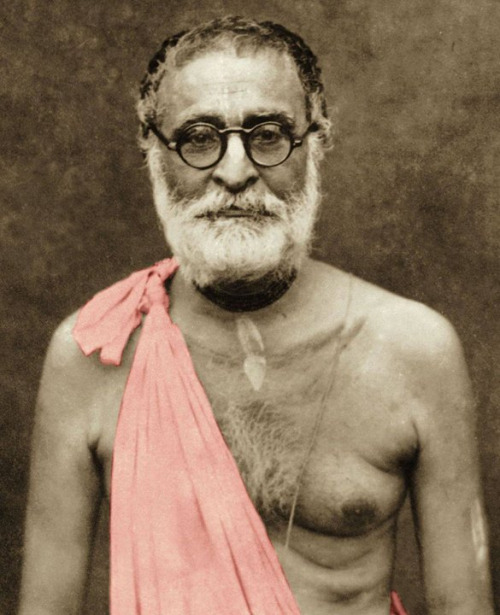
In January of 1930 Srila Sarasvati Thakur installed Deities of Radha and Govinda at the Triveni at Allahabad – the the confluence of the three holy rivers: the Ganges, Yamuna and Sarasvati. This was on the occasion of the Purna Kumbha-mela – a huge pilgrimage and festival held at various holy places on the Ganges – and he sent out his team of preachers in the area to enlighten people. His preaching work was increasingly more organized. His teams would canvass from door to door, asking for contributions, selling subscriptions to their magazines, starting centers, making devotees, etc.
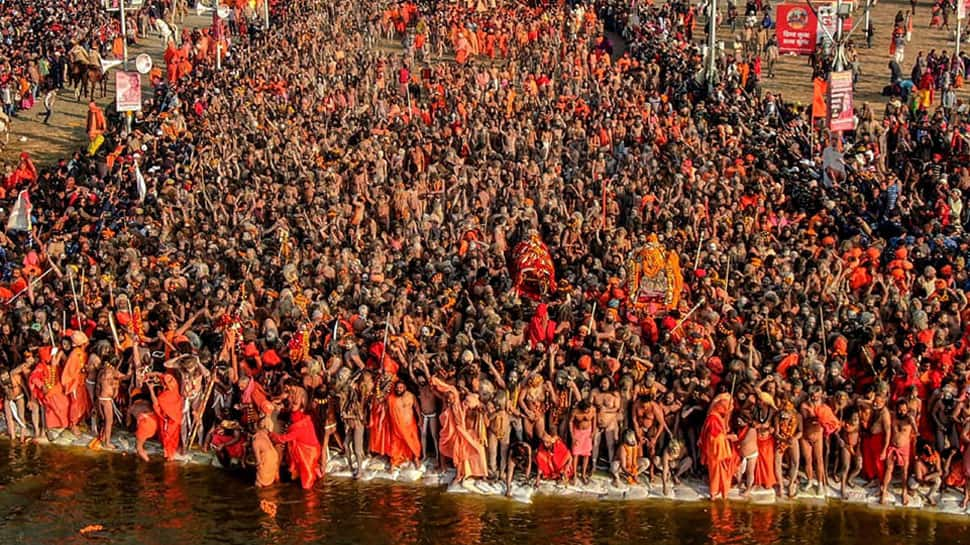
Purna Kumbha-mela at Allahabad
Srila Sarasvati Thakur was making lecture tours, talking with intellectuals and scholars of the day, presiding over installations of Deities, initiations and festivals organized for diorama exhibitions, temple openings, prasadam distribution, etc. Meanwhile, his presses were rolling, producing books. He was even meeting with the English governors, viceroys, Indian kings, etc. and encouraging them to assist in the opening of his temples and projects. Of course this was frowned upon by some of the nationalists and religious purists, but Srila Sarasvati Thakur was far removed from the bodily concept of life; his idea was to involve and purify everyone in the flood of the sankirtan movement of Sri Chaitanya Mahaprabhu.
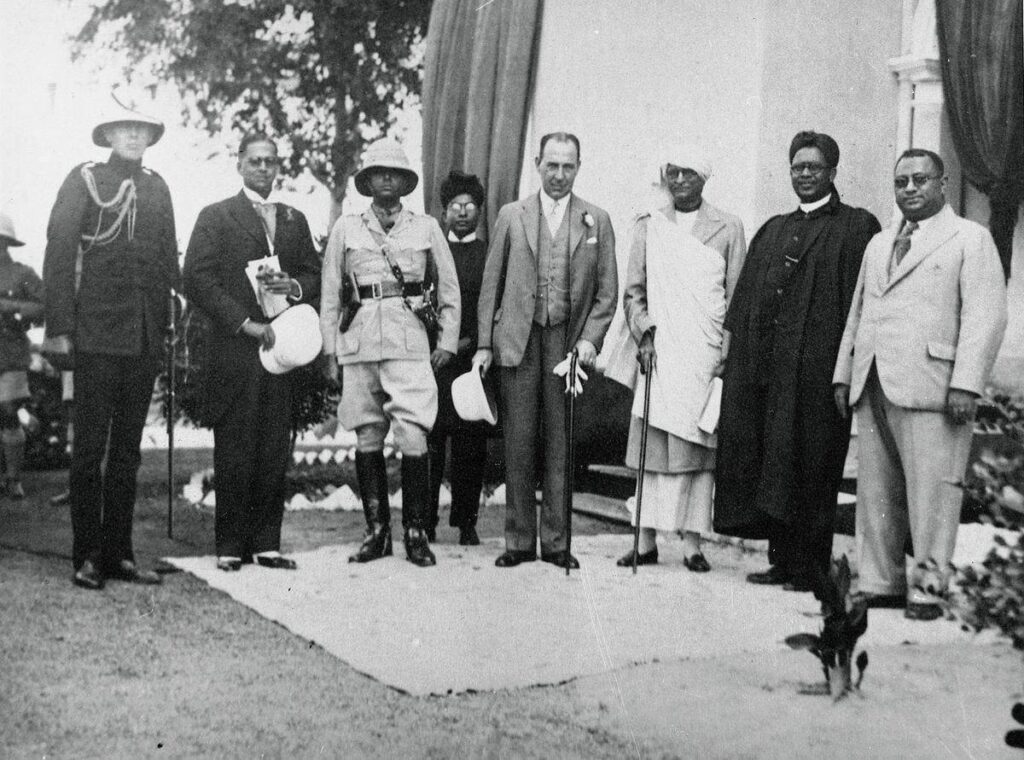
Bhaktisiddhanta met with English governors, viceroys, Indian kings and various dignitaries
In February of 1930 a tremendous diorama exhibition called the Sreedham Mayapur Navadwip Exhibition was opened in that holy site, which contained many stalls exhibiting the stories and lessons from the Srimad-Bhagavatam. It created a sensation, thousands flocked to see it, and it remained open for a month and a half. On October of 1930 there was a magnificent installation ceremony of Sri Radha Madana-mohana, Radha Govinda and Radha Gopinatha at the Gaudiya Math in Baghbazar, Calcutta. A palatial marble temple had been constructed with the help of a wealthy Vaisnava merchant.
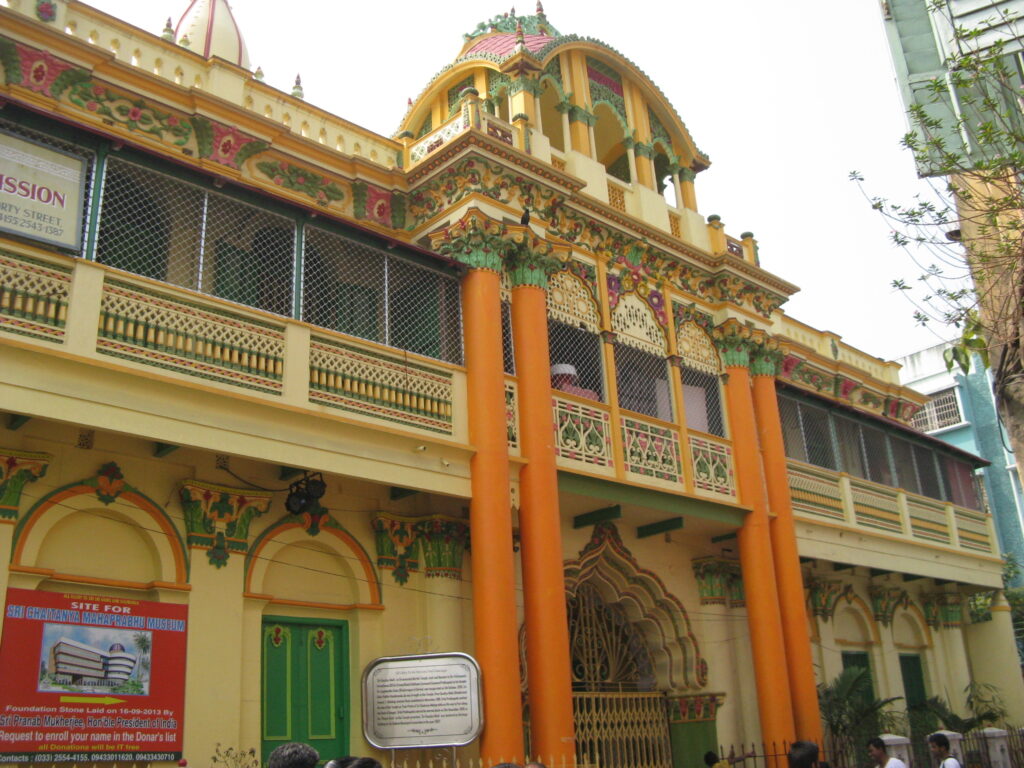
Gaudiya Math Temple in Baghbazar, Calcutta
This was Srila Sarasvati Thakur’s practical exhibition of the principle of yukta-vairagya: to utilize the material energy for Krishna’s purposes. Although previously Vaisnavas tended to avoid the cities and live in seclusion, Srila Sarasvati Thakur’s idea was to have his sannyasi and brahmacari preachers go to the cities and establish temples and tend to the spiritual welfare of the masses. Thus, the small beginnings in Calcutta at No. 1 Ultadanga Junction Road had culminated in a magnificent temple with a conference hall for discourses, many rooms, a library, press, etc.
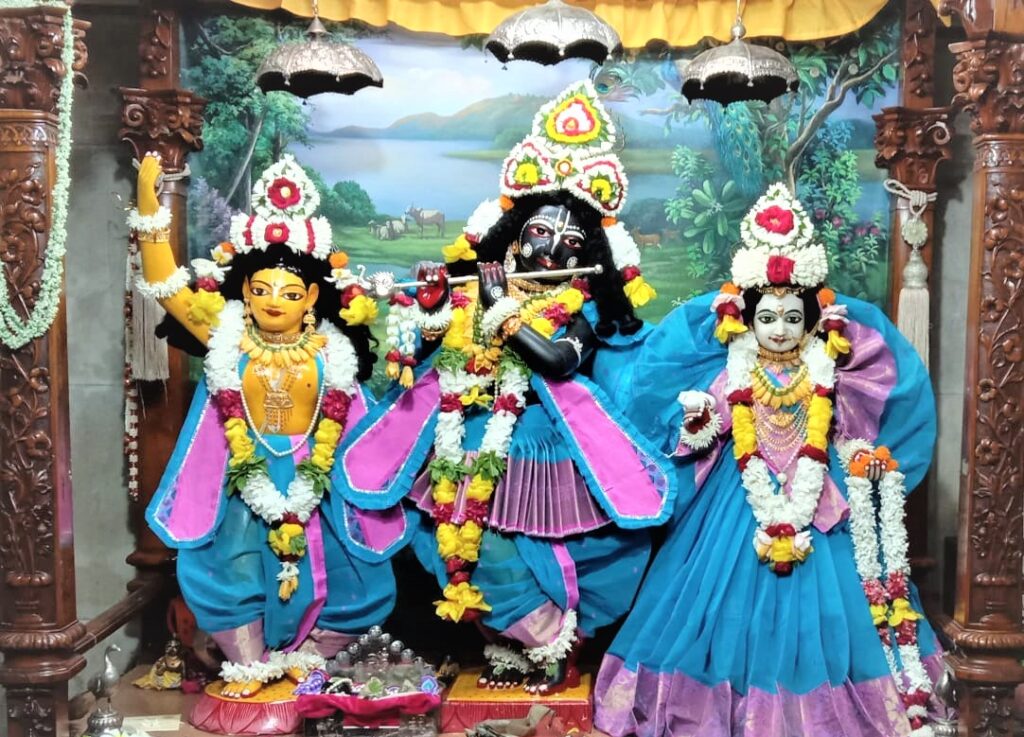
Deities at Baghbazar Temple
Srila Sarasvati Thakur’s ideas were considered revolutionary: sannyasis riding in motor cars, wearing sewn cloth, buying the most modern printing presses, staging huge exhibitions with dioramas illustrating the profound philosophy of Srimad-Bhagavatam and Caitanya-caritamrta. Nothing like it had ever been attempted before.
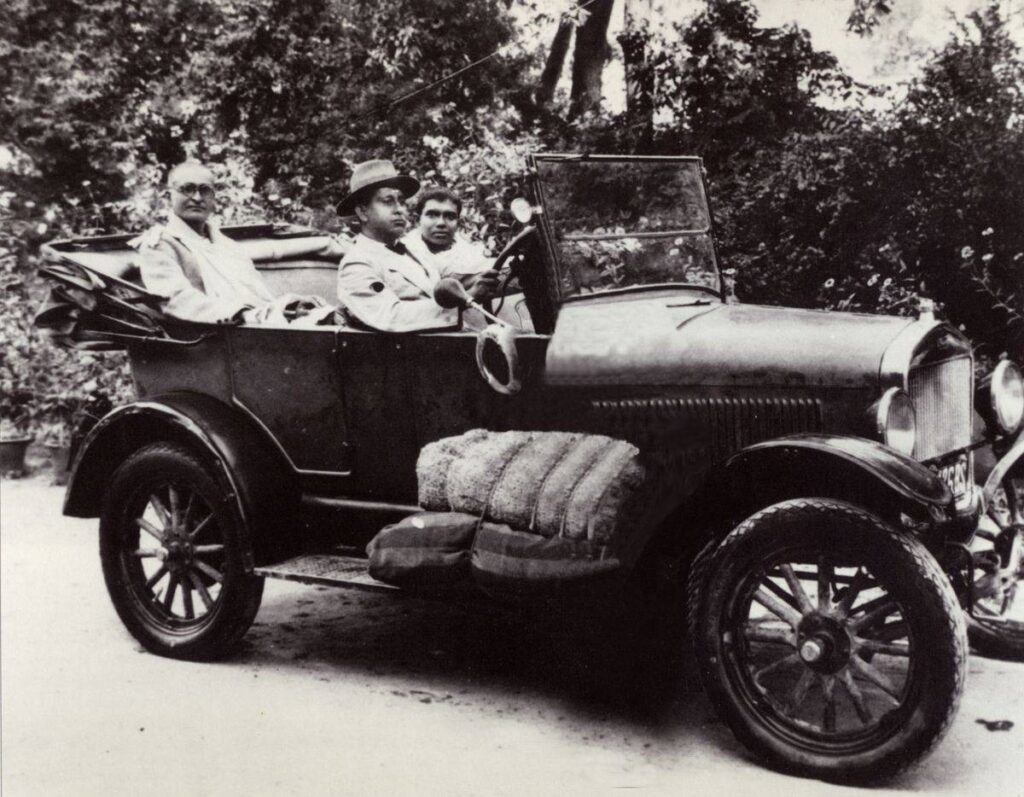
Srila Bhaktivinoda Thakur had laid the groundwork by reviving interest in Vaisnava thought, establishing its credibility and respectability, publishing the books of the Gosvamis of Vrindavan, and also creating his own brilliant transcendental storehouse of Vaisnava literature, poetry, songs and deep philosophical tracts. Now Sarasvati Thakur was distributing it, publicizing it, writing books, and creating a sensation. His activities were that of an empowered preacher. He preached to the intellectuals all over India, had exhibitions, established many temples, established pada-pithas [footprints of Mahaprabhu], wrote many books, published magazines, held huge festivals, re-established holy places, installed Deities, etc. He burned with the desire to fulfill Lord Chaitanya’s mission, to spread Krishna consciousness all over the earth.
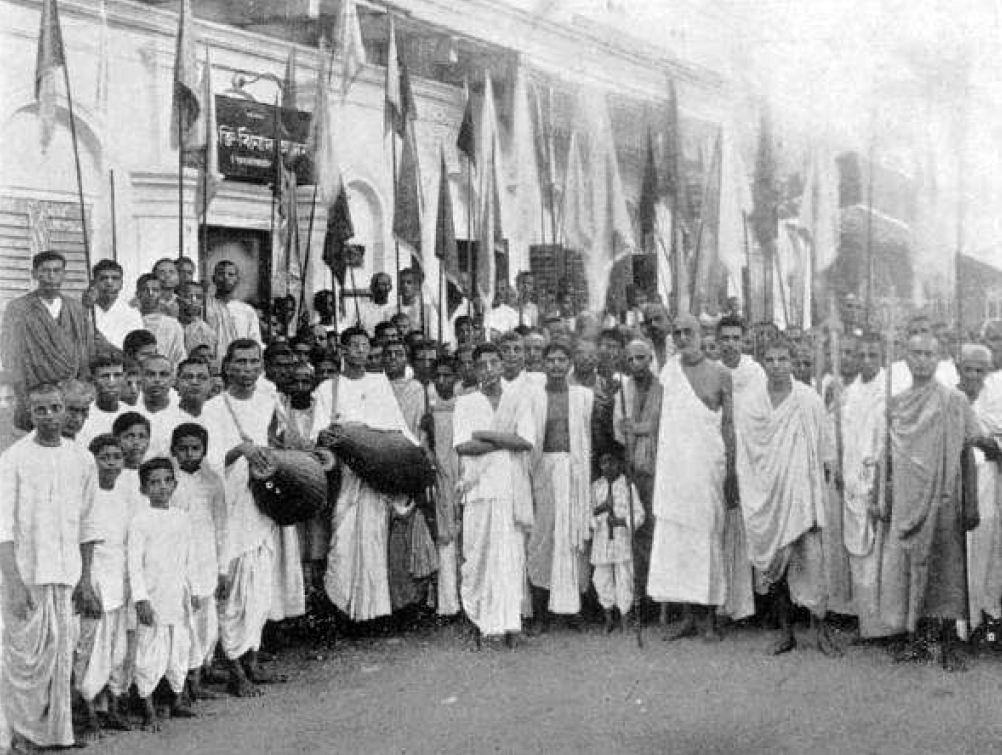
By year’s end he had preached in Jajpur, Kurukshetra, Simhachal, and Kovvur, the site of the meeting and discussion between Ramananda Raya and Sri Chaitanya Mahaprabhu. In 1931 a school was opened in Mayapur – the Thakur Bhaktivinoda Institute. At that time it was the only English medium high school based on spiritual instruction. Srila Sarasvati Thakur delivered a lecture called Apara and Para Vidya (Material and Spiritual Education) at the opening. Deities were established in Alalanath, where years earlier he had entered the trance of ecstasy and become lost in the forest. He also established Deities in New Delhi, the capital of India and the former capital of the Pandavas.
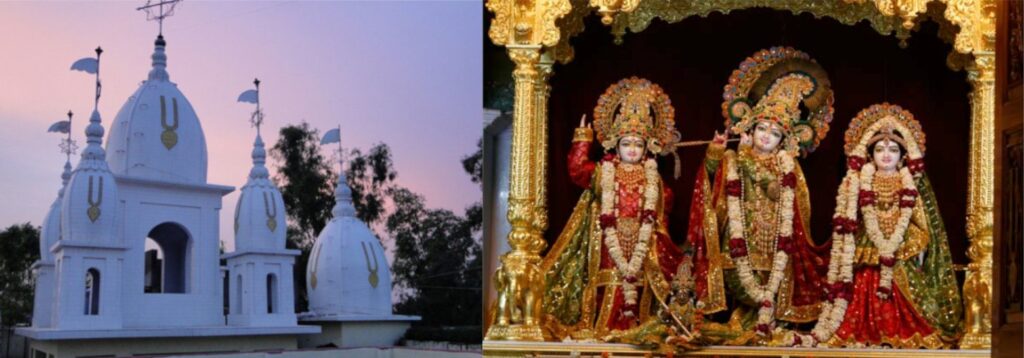
New Delhi Gaudiya Math Temple
He spoke to many scholars like Dr. Magnus Hirschfeld from Germany, Dr. Stella Kramrisch, another German scholar who taught in Calcutta University, and Mr. A. J. Jacob from America. To all he taught the importance of hearing the transcendental sound from a transcendental agent – only hearing transcendental sounds from liberated souls can show us the way of transcending the illusory material sphere:
… Godhead sends down His messengers in symbolised figures to give us, if we are at all really sanguine (confidently optimistic), ideas of the Absolute. It is only then that we would be enabled to make any progress. This fortune is denied to all who have love for transformable things. … We must not neglect the transcendental Sound freely transmitted by the agents of the Absolute. …
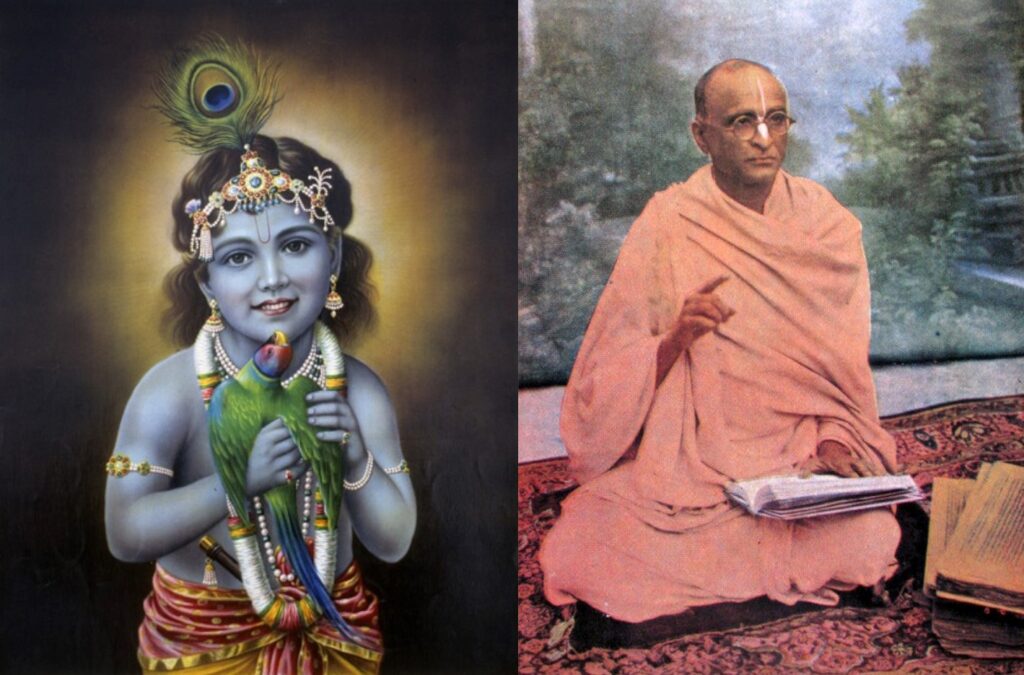
We want to rouse up the true mentality of the civilized world for seeking true help towards spiritual progress. The secular help cannot appease our inner hunger. The transcendental Help can. We intelligent people should receive this transcendental Sound. We are now vitally concerned in this as every one is engaged in exploring ways and means for getting rid of our present unbearable inadequacies. We should spare a portion of our time to receive those Sounds.

Lord Willingdon and Srila Bhaktisiddhanta Sarasvati Thakur
In November of 1931 Srila Bhaktisiddhanta Sarasvati Thakur sent the preachers from his Delhi Math with a spiritual message to the then Viceroy of India, Lord Willingdon. Srila Sarasvati later delivered some lectures in Delhi in the latter part of that year and glorified the Srimad-Bhagavatam at Sukaratala, the place where Sukadeva Gosvami delivered the Bhagavatam to Maharaja Pariksit 5,000 years earlier.
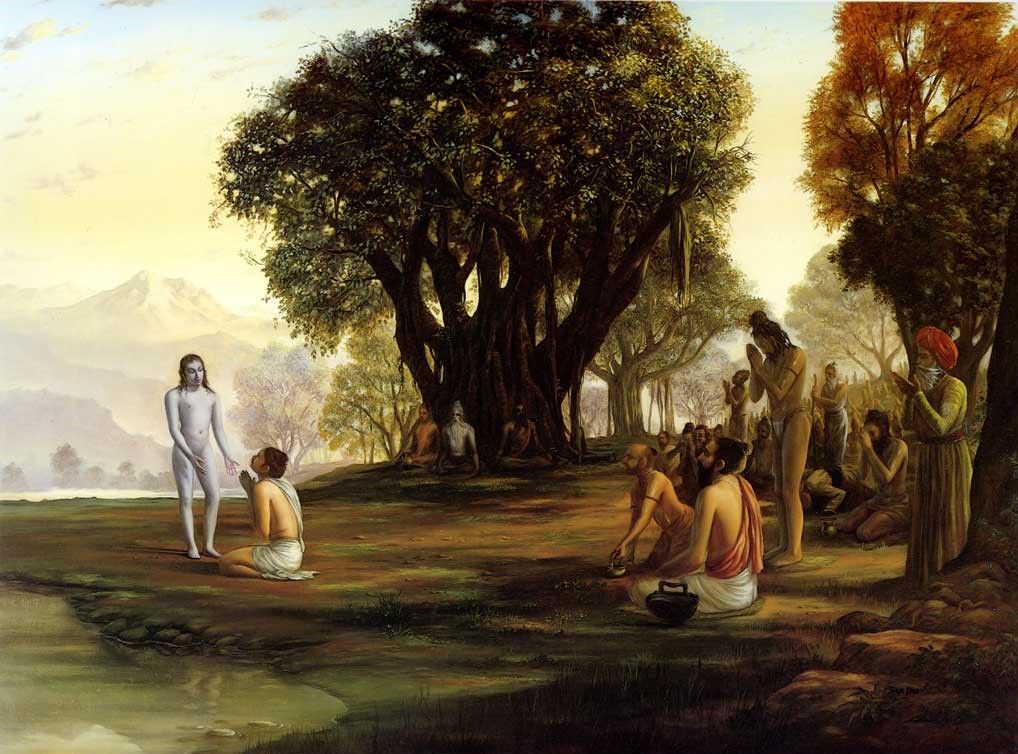
Sukaratala, where Sukadeva Gosvami delivered the Bhagavatam to Maharaja Pariksit
In 1932 Deities were installed in Madras, and many well-attended discourses were held in the area. In May of that year he revised and corrected a scholarly English presentation on the life of Sri Chaitanya Mahaprabhu called Sree Krishna Chaitanya, which was composed by one of his disciples who was a professor at Ravenshaw College named Dr. Nishikanta Sanyal. The work compiled the pastimes of the Lord from all the prominent biographies of the Lord written by his immediate followers, especially the Chaitanya Bhagavata and Caitanya-caritamrta. Professor Sanyal also was the editor of the English Harmonist magazine of Srila Sarasvati Thakur.
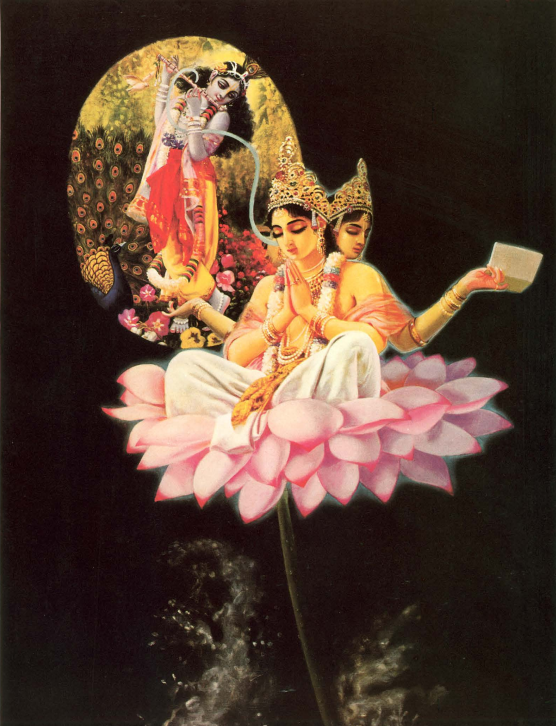
Lord Brahma receiving Vedic wisdom from Lord Krishna at the beginning of creation
At this time, Srila Sarasvati Thakur also checked the proofs of his own English presentation of Brahma-samhita with Sanskrit commentary by Srila Jiva Gosvami, a book discovered by Sri Chaitanya Mahaprabhu in His travels, which perfectly elucidated His teachings about Krishna. When Lord Chaitanya visited the temple of Adi-kesava in South India on the bank of the Payasvini River, He discussed some spiritual topics with highly advanced devotees there, and while there He found a chapter of Brahma-samhita. The book, spoken in ancient times by Lord Brahma, was originally much longer but the Fifth Chapter was all that remained.
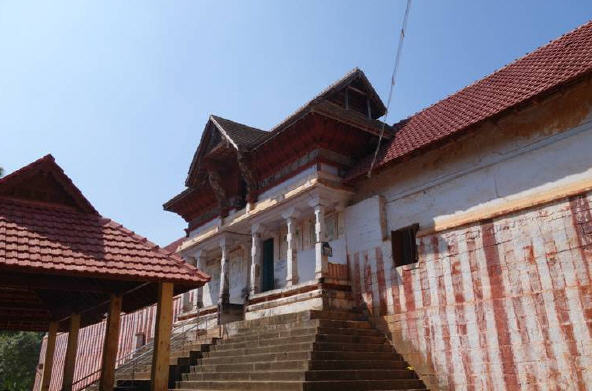
Adi-keshava Temple
This incident is described in the Caitanya-caritamrta by His Divine Grace A.C. Bhaktivedanta Swami as follows:
Sri Chaitanya Mahaprabhu was greatly happy to find a chapter of that scripture, and symptoms of ecstatic transformation – trembling, tears, perspiration, trance and jubilation – were manifest in His body. There is no scripture equal to the Brahma-samhita as far as the final spiritual conclusion is concerned. Indeed, that scripture is the supreme revelation of the glories of Lord Govinda, for it reveals the topmost knowledge about Him. Since all conclusions are briefly presented in Brahma-samhita, it is essential among all the Vaisnava literatures.
[Caitanya-caritamrta Madhya 9: 238-240]
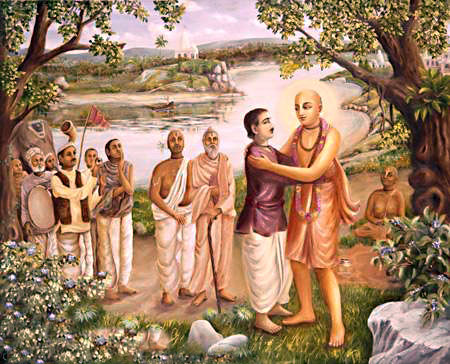
Lord Chaitanya meeting Ramananda Raya
Later, in the same chapter of Caitanya-caritamrta, it is described how Lord Chaitanya gave the Brahma Samhita to Ramananda Raya:
Sri Chaitanya Mahaprabhu gave Ramananda Raya a vivid description of His travels to the holy places and told him how He had acquired the two books named Krishna-karnamrta and Brahma-samhita. The Lord delivered the books to Ramananda Raya. The Lord said, “Whatever you have told Me about devotional service is all supported by these two books.” Ramananda Raya was very happy to receive these books. He tasted their contents along with the Lord and made a copy of each.
[Caitanya-caritamrta Madhya 9: 323-325]
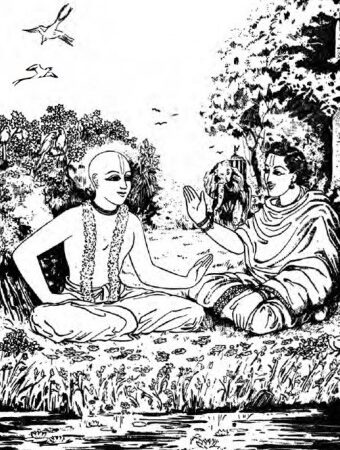
From this we can see the importance Lord Chaitanya gave to this scripture – He personally copied it down with His own hand. Later, Ramananda Raya made a copy, and in this way it was passed on in handwritten copies until Srila Bhaktisiddhanta Sarasvati Thakur published it on a large scale for the first time in 1932. During this period Srila Bhaktisiddhanta Sarasvati Thakur also completed his Gaudiya Bhasya commentary on the Chaitanya-bhagavata and wrote a short English biography called Rai Ramananda, an account of the life of Srila Ramananda Raya.
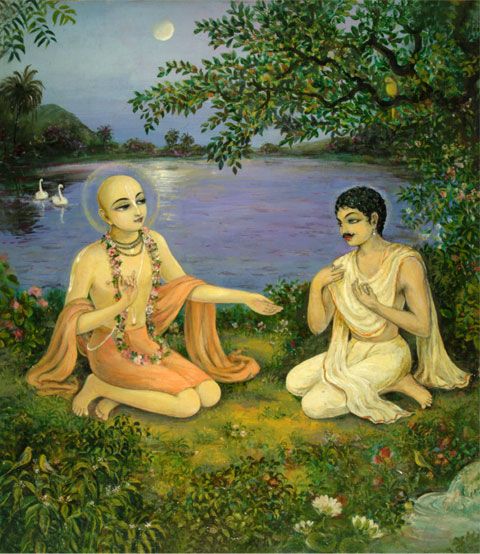
Lord Chaitanya and Ramananda Raya
The first part of this book presents the external biographical facts and figures of the great Vaisnava’s life. This section reveals nothing of Raya Ramananda’s true identity. In the second part of this book, Srila Sarasvati Thakur shines a torch on the deepest inner reality of Ramananda’s spiritual form and spiritual identity. The message here is that the entry into the understanding of the true glories of a great Vaisnava can only be granted by another great Vaisnava, like Srila Bhaktisiddhanta Sarasvati Thakur.
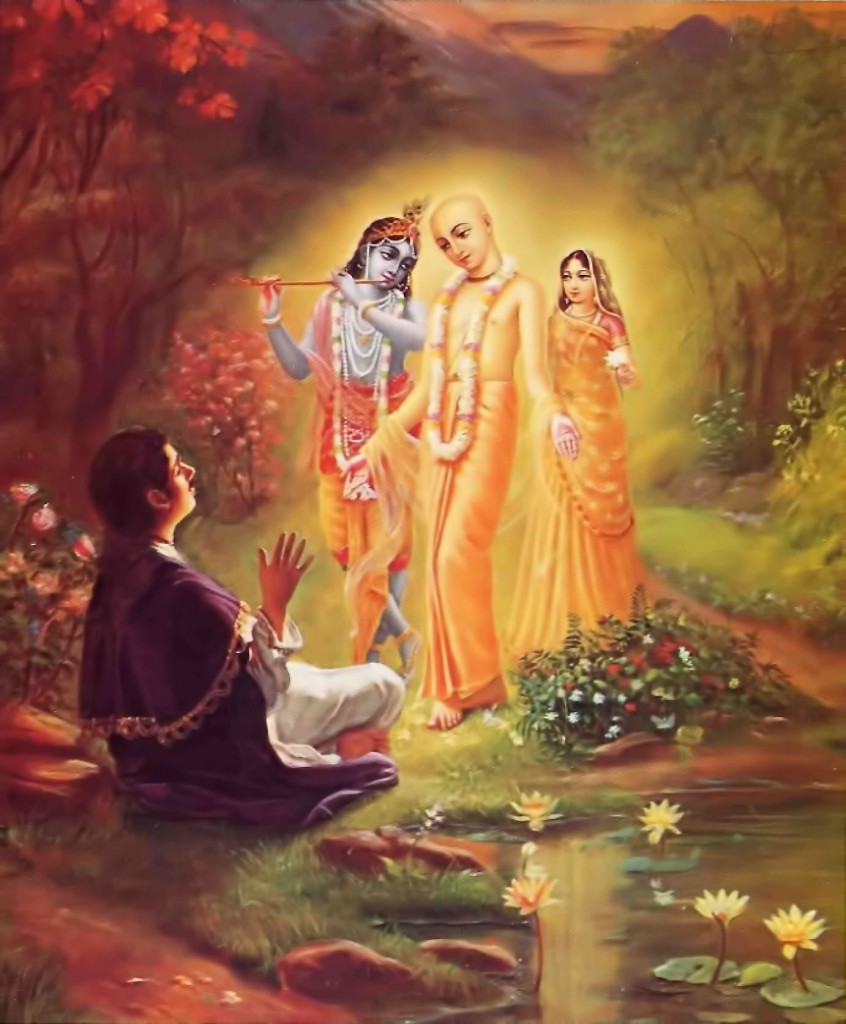
Lord Chaitanya revealed His identity as Radha and Krishna combined to Ramananda
In June of 1932 he visited the Maharaja of Mysore and stayed as a guest in his Ramya Palace where he delivered a series of discourses about Lord Chaitanya’s philosophy. He then preached in Bangalore and then travelled to Kovvur where he installed Deities near the transcendental site of the conversations between Lord Chaitanya and Ramananda Raya.
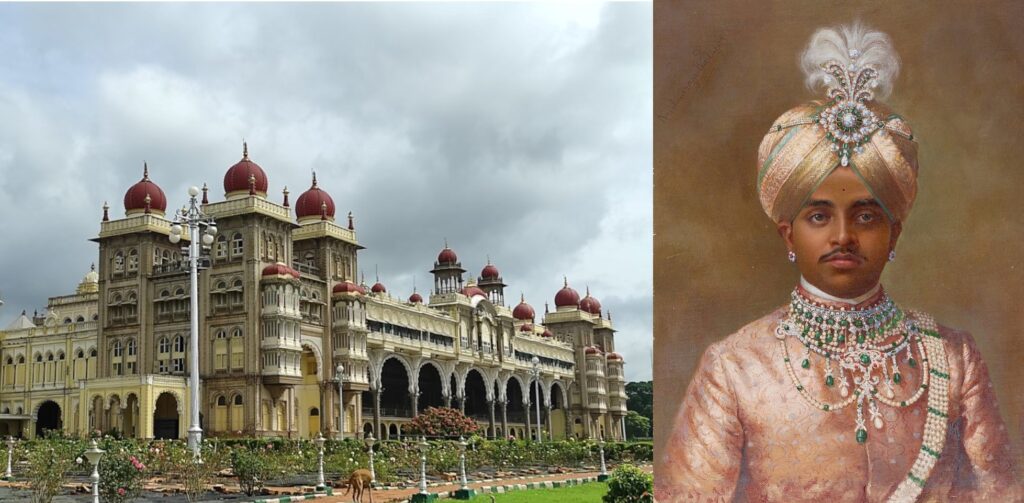
The Maharaja of Mysore and his Ramya Palace
In October and November of 1932 the Circumambulation of Vraja Mandala was held, accompanied by many thousands of pilgrims. Srila Sarasvati Thakur toured all of the sacred places of Krishna’s pastimes and engaged constantly in chanting the name and glories of the Lord on the actual sites of the Lord’s pastimes. The pilgrimage required massive organization with many tents, a moving kitchen, stage equipment, animals, etc.
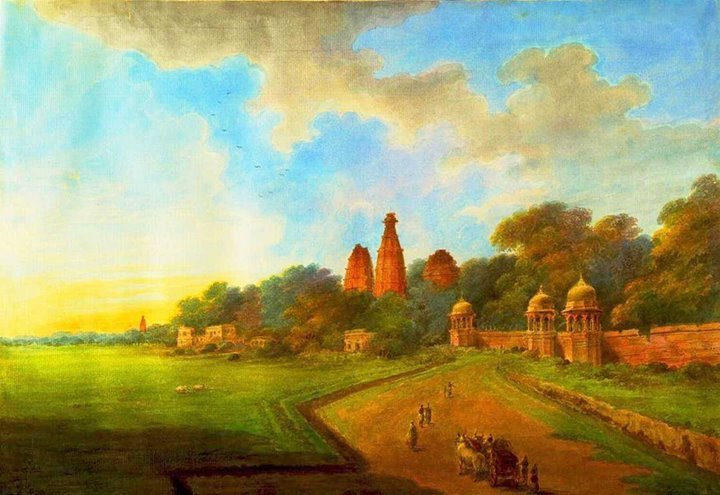
Vraja Mandala [Vrindavan]
The pilgrims would rise early, chant and proceed in a huge procession with kirtan accompanying the Deity of Lord Chaitanya, a police band, a lead horse, flag bearers and all of the followers. At night a city of tents would be erected, kirtan and discourse areas would be set up, along with the kitchen, and there was even a system of guards for the tents.
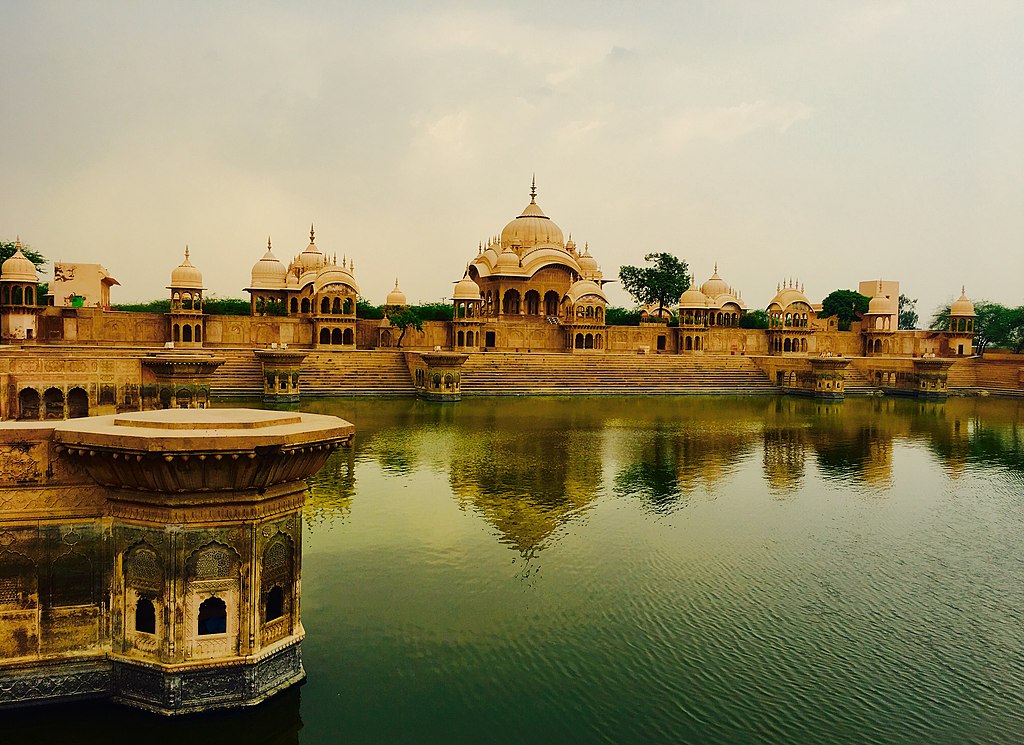
Nandisvara, Vrindavan
However, the pilgrimage encountered opposition in the form of many of the Vrindavan temple proprietors – the caste Gosvamis – who objected to Srila Sarasvati Thakur’s awarding of brahminical status to those not born in brahman families. Although Srila Bhaktisiddhanta had established this practice strictly in accordance with the teachings of the Hari-bhakti-vilasa by Srila Sanatan Gosvami, who was one of the founding fathers of the present town of Vrindavan, still the pandits did not approve what they considered the deviation of giving brahman and sannyas initiation to members of lower castes.
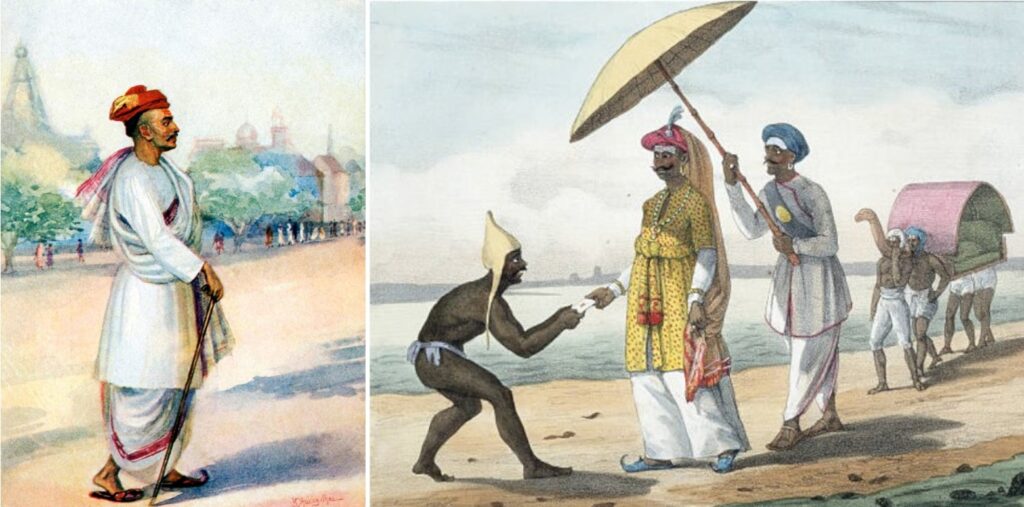
Entitled Caste Brahmans
Srila Bhaktisiddhanta said on this matter of caste brahmanism:
God is worshipped not only by Brahmans. Everyone has right to call upon and worship Him. Everyone can have the right to wear the sacred thread. Get rid of your sins and impurities and you become Brahman and not otherwise by the accident of your birth.
In this regard, in 1970 Srila Bhaktivedanta Swami wrote an extensive reply to a query about this matter from one of his disciples, explaining some of the background of this controversy:
Regarding the validity of the brahminical status as we accept it, because in the present age there is no observance of the Garbhadhana ceremony, even a person born in a brahman family is not considered a brahman – he is called dvija-bandhu or “unqualified son of a brahmana.” Under the circumstances, the conclusion is that the whole population is now sudra, as it is stated “*kalau sudra sambhava.” So for sudras there is no initiation according to the Vedic system, but according to the pancaratrika system, initiation is offered to a person who is inclined to take Krishna consciousness.
[The phrase *kalau sudra-sambhavah originates from the following verse found in the Skanda Purana:
In the Kali-yuga brahmans will certainly become like – be born as – impure sudras.]
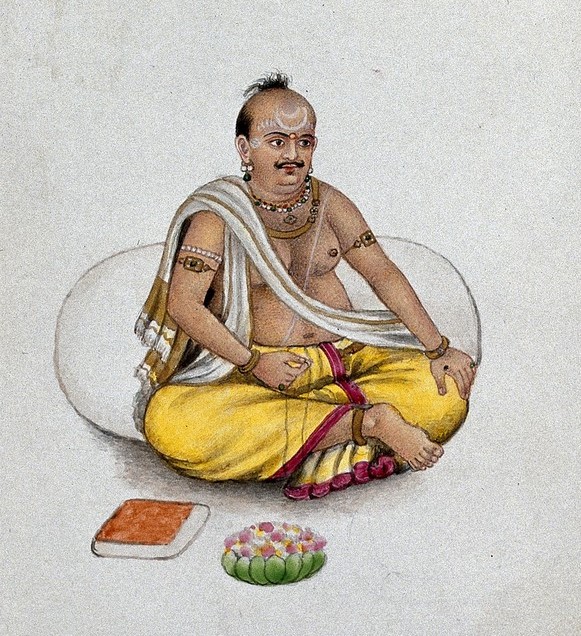
During my Guru Maharaj’s time, even a person was coming from a brahman family, he was initiated according to the pancaratrika system taking him to be a sudra. So the birthright brahmanism is not applicable at the present moment. The sacred thread inaugurated by my Guru Maharaj according to pancaratrika system and Hari-bhakti-vilasa by Srila Sanatan Goswami must continue. It does not matter whether the priestly class accepts it or not. When my Guru Maharaj Bhaktisiddhanta Sarasvati Goswami Prabhupad introduced this system, it was protested even by his inner circle of Godbrothers and friends. Of course, he had actually no Godbrothers, but there were many disciples of Bhaktivinoda Thakur who were considered as Godbrothers who protested against this action of my Guru Maharaj, but He didn’t care for it.
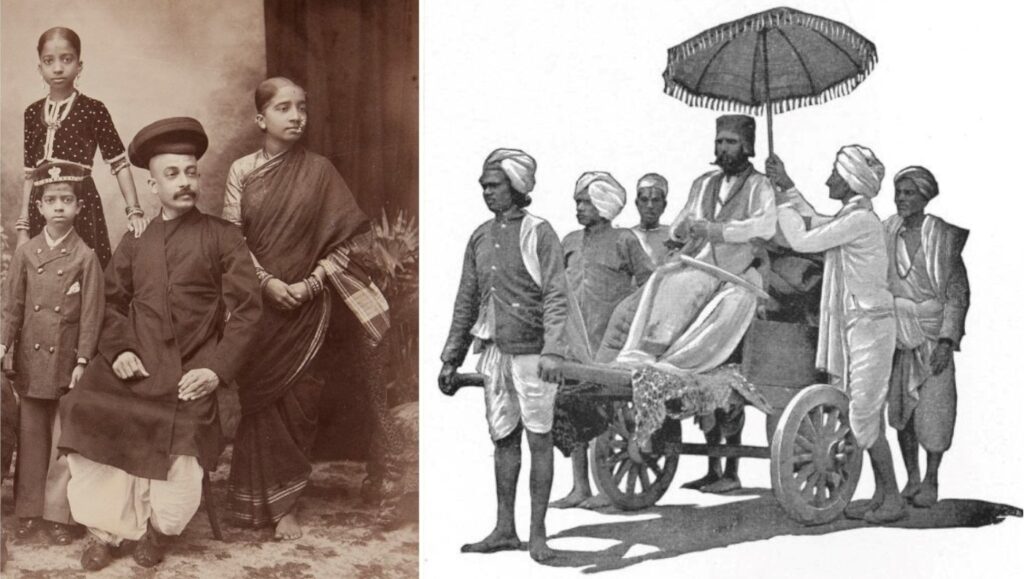
Caste Brahmans
Actually, one who takes to chanting Hare Krishna mantra offenselessly, immediately becomes situated transcendentally and therefore he has no need of being initiated with sacred thread, but Guru Maharaj introduced this sacred thread because a Vaisnava was being mistaken as belonging to the material caste. To accept a Vaisnava in material caste system is hellish consideration (naraki buddhi). Therefore, to save the general populace from being offender to a Vaisnava, He persistently introduced this sacred thread ceremony and we must follow His footsteps … This system introduced by my Guru Maharaj is a chance for all the members of the society, scientifically based and applied, apart from the exploitative sentiment of birthright “caste” system, to become actually situated on the transcendental platform.
[Srila Bhaktivedanta Swami, letter 1970]
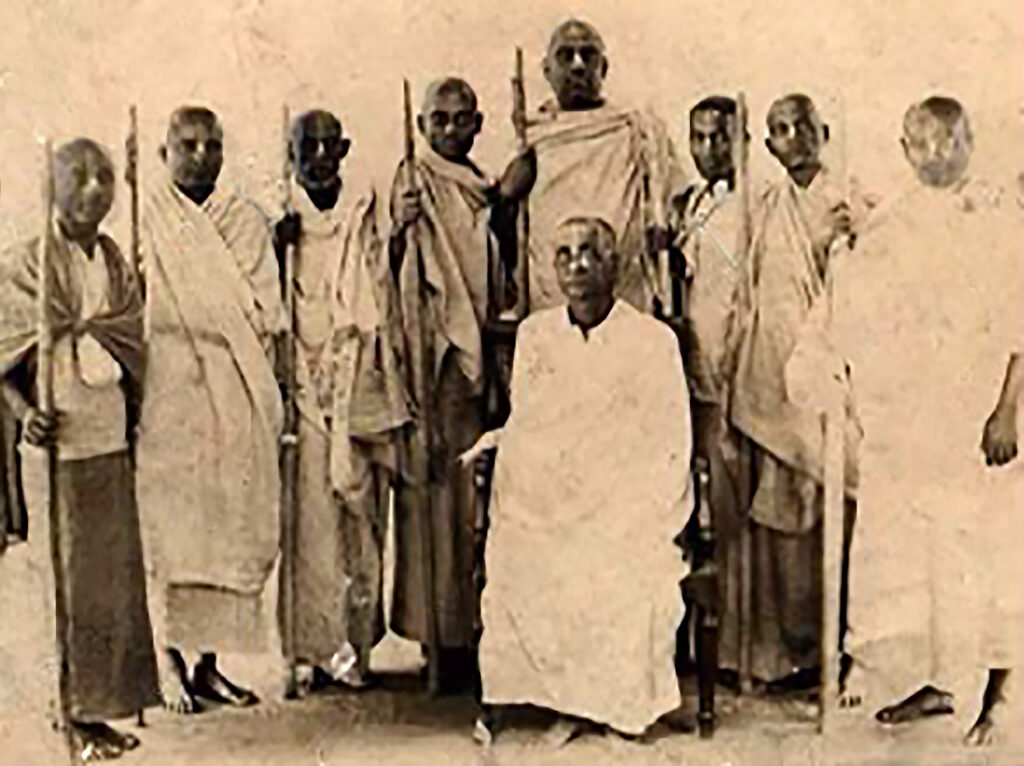
Srila Bhaktisiddhanta Sarasvati and some of his Sanyassi disciples
The pandits met with Srila Bhaktisiddhanta Sarasvati Thakur and a discussion took place. Although the pandits appeared satisfied with the talks, when the parikrama reached the seven main temples, the doors were closed. Shopkeepers closed their shops, and some people even threw stones at them. Finally, they reached Kosi. It was at this point of the pilgrimage that Srila Bhaktivedanta Swami Prabhupad met Srila Bhaktisiddhanta Sarasvati Thakur, having travelled from Allahabad, and he sat with rapt attention hearing him speak for many hours. And it was at this time that Srila Bhaktisiddhanta Sarasvati Thakur remarked of him:
He likes to hear. He does not go away.
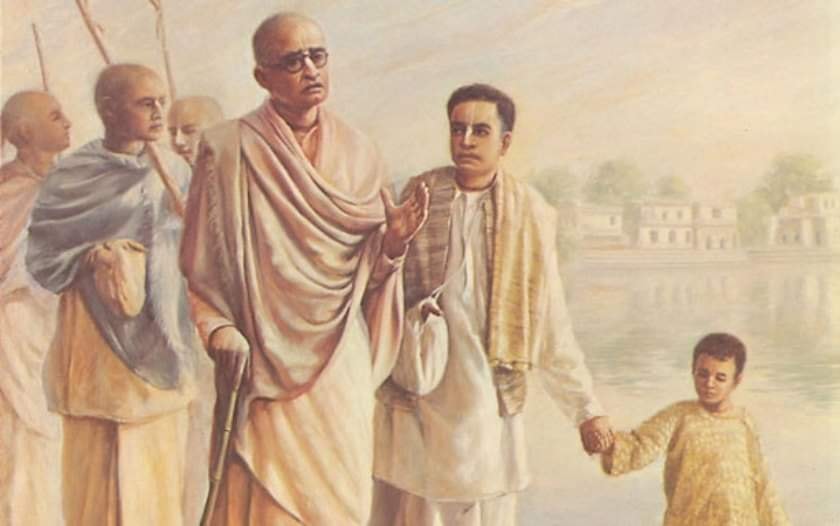
Srila Bhaktivedanta Swami listened intently to his spiritual master
The pilgrimage was unprecedented in scope, almost like a moving city. The 168 mile circumambulation took from the 9th of October to the 11th of November (1932). During the Radha-kunda portion of the tour, a talk was given at the junction of Radha Kunda and Shyama Kunda, on the subject of Sri Upadesamrta (“The Nectar of Instruction”) by Srila Rupa Gosvami.
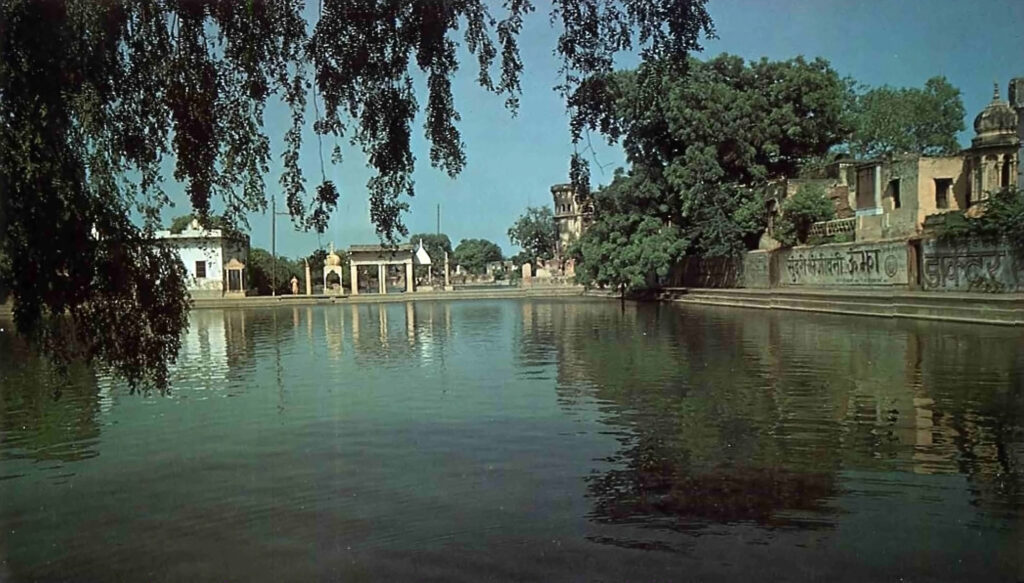
Radha-kunda – Radharani’s bathing pool
A large audience of Vrajavasis – residents of Vrindavan – and pandits were fortunate enough to hear him speak. This wonderful discourse was delivered by the ecstatic preacher who is described in pranam prayer:
madhuryojjvala-premadhya-sri-rupanuga-bhaktida
sri-gaura-karuna-sakti-vigrahaya namo ’stu te
I offer my respectful obeisances unto you, the personified energy of Sri Chaitanya’s mercy, who deliver devotional service which is enriched with conjugal love of Radha and Krishna, coming exactly in the line of revelation of Srila Rupa Gosvami.
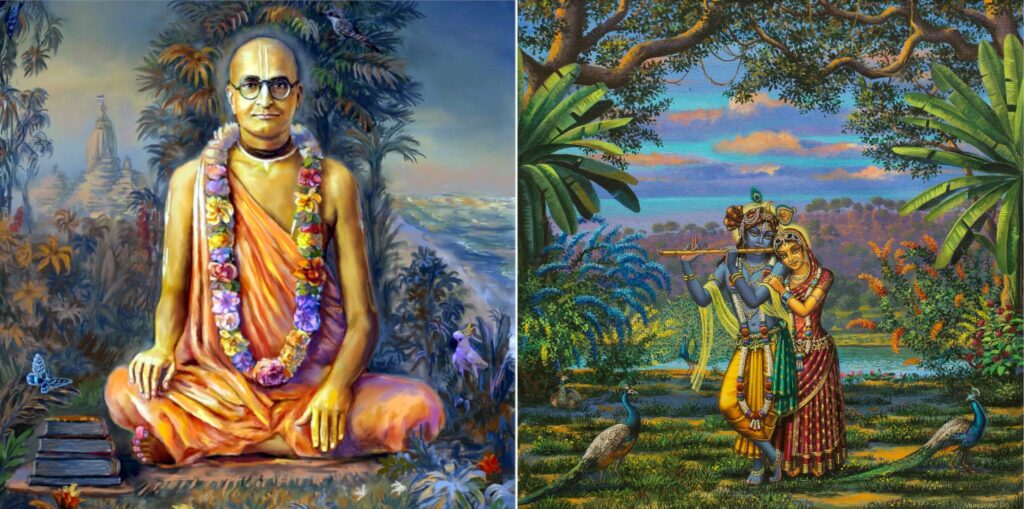
At the conclusion of the parikrama, Srila Sarasvati Thakur proceeded to Allahabad (Prayag) where he oversaw the laying of the foundation stone for the Sree Rupa Gaudiya Math in Allahabad. Sir (William) Malcolm Hailey, the Governor of the United Provinces – later Uttar Pradesh – was on hand for the occasion and personally laid the cornerstone in Srila Sarasvati Thakur’s presence.
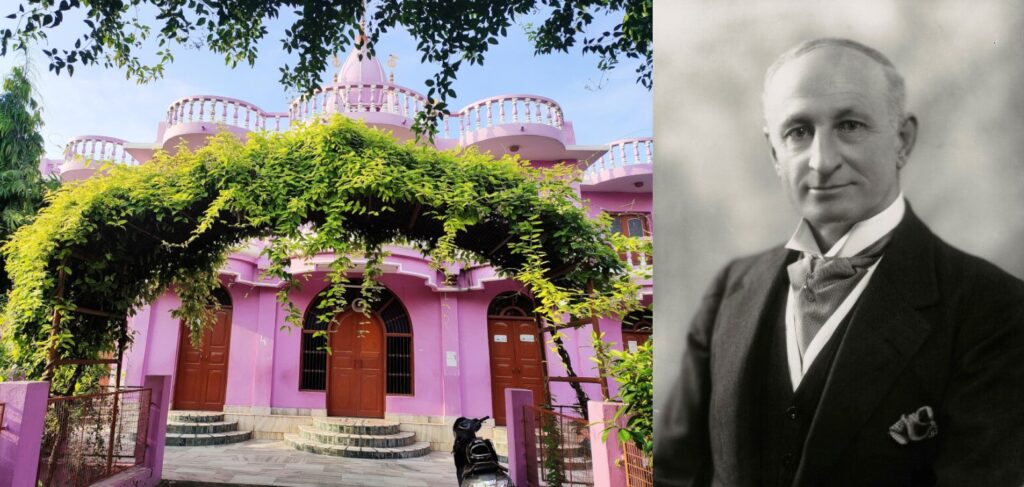
Sir Malcolm Hailey and the Sree Rupa Gaudiya Math in Allahabad
Srila Bhaktivedanta Swami was living in Allahabad at this time as a householder, running the “Prayag Pharmacy.” It was there (in January of 1933) that Srila Bhaktivedanta Swami received Harinama and brahman (first and second) initiations from Srila Sarasvati Thakur, who was pleased to see him. When he was presented as a candidate for initiation, Srila Sarasvati Thakur commented again:
Yes, he likes to hear. He does not go away. I have marked him. I will make him my disciple.
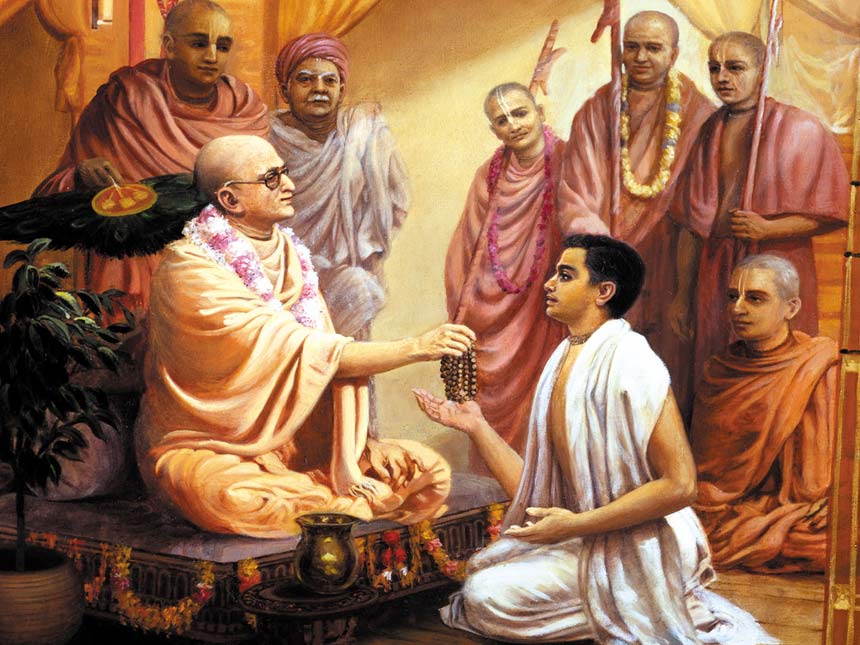
Srila Bhaktisiddhanta Sarasvati initiates Srila Bhaktivedanta Swami in January of 1933 at Allahabad
Srila Sarasvati Thakur’s preaching was going on in a big way. He had teams of sannyasis and brahmacaris constantly travelling and preaching, distributing magazines and books, establishing centers, arranging programs, etc. A core of 18 sannyasis were organizing things. His propaganda attracted so many people that Subhas Chandra Bose, the famous nationalist and a former classmate of Srila Bhaktivedanta Swami’s at Scottish Churches’ College, met with Srila Bhaktisiddhanta Sarasvati Thakur and complained:
So many people you have captured. They are doing nothing for nationalism.
Srila Bhaktisiddhanta Sarasvati’s hilariously replied:
Well, for your national propaganda you require very strong men, but these people are very weak. You can see, they are very skinny. So don’t put your glance upon them. Let them eat something and chant Hare Krishna.
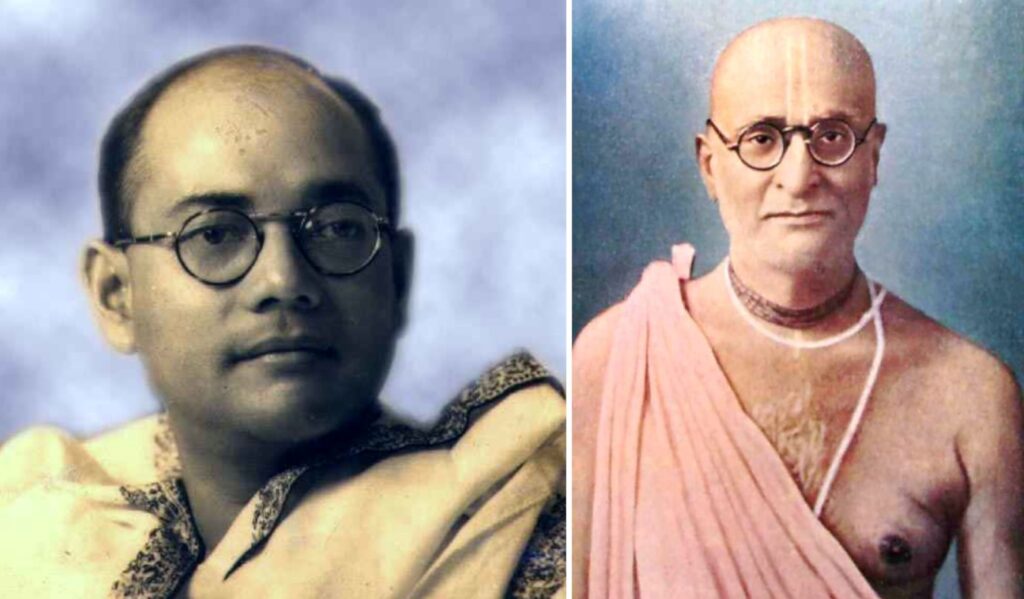
Subhas Chandra Bose and Bhaktisiddhanta Sarasvati
Srila Bhaktivedanta Swami Prabhupad commented on this incident: In this way he avoided him.
The kind of revolution Srila Sarasvati Thakur had in mind could not be appreciated by Mr. Bose. In January of 1933 a large diorama exhibition was opened in Dacca (presently the capital of Bangladesh, it was then a part of India). Called Sat Siksha, it featured toys, dolls, etc., and Srila Bhaktisiddhanta gave discourses there for one month to large crowds of learned and respectable people.
The Message Is Sent To The West
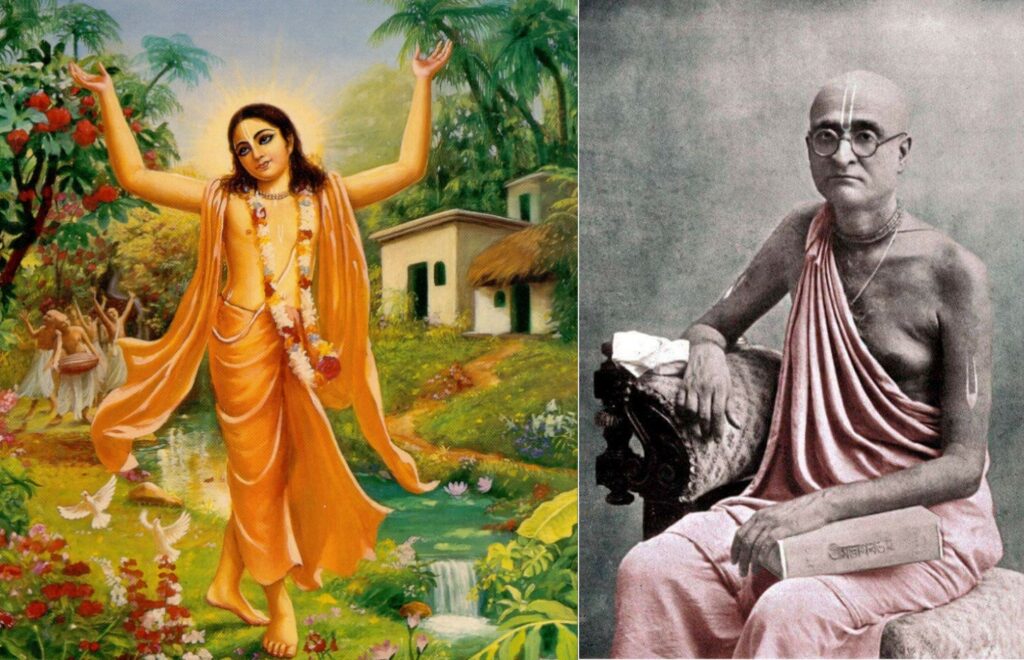
After the annual Gaura Purnim (Lord Chaitanya’s birth) celebration and circumambulation of Sri Navadvipa-dhama of 1933, Srila Sarasvati Thakur resolved to further expand his preaching of Krishna consciousness to Europe, in line with the desires of Sri Chaitanya Mahaprabhu and Srila Bhaktivinoda Thakur. Inspirationally, on Lord Chaitanya’s Appearance Day, the thick English volume Sree Krishna Chaitanya by his disciple Professor Sanyal was brought out, in a beautifully bound edition.
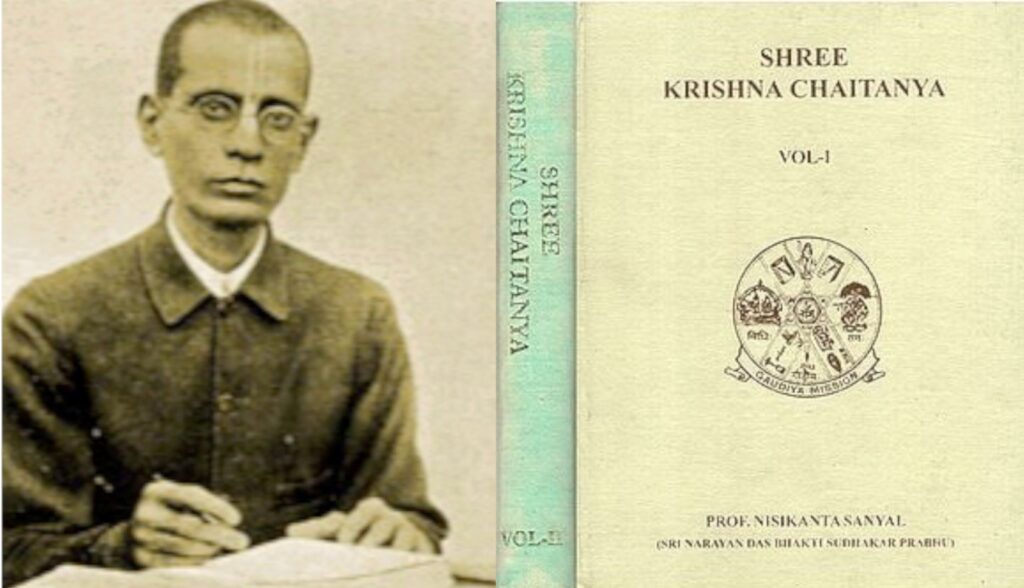
Professor Nisikanta Sanyal
On the 18th of March Srila Sarasvati Thakura gave instructions to two of his sannyasi disciples and a third disciple in a special meeting in Madras which served as a farewell address. The three disciples were to proceed to Europe on behalf of their Guru Maharaja. The instructions he gave them form a brilliant essay on the mood and behavior of a preacher in foreign lands. Reading it, it is a perfect description of Srila Bhaktivedanta Swami Prabhupada, who was the ideal preacher according to the criteria of Srila Sarasvati Thakur. The talk entitled L’Envoi – which means “one who is dispatched on a mission, a messenger” – was later published as an essay in the collected English writings of Srila Bhaktisiddhanta Sarasvati Thakur. I have attached some excerpts from this talk below:
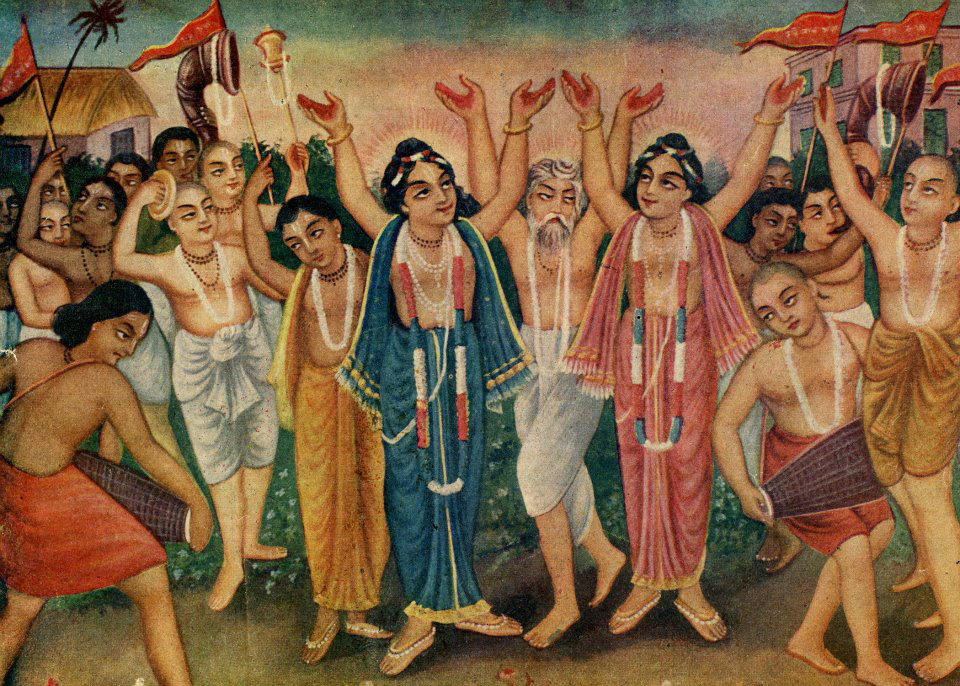
The happy day has come when we are destined to spread the message of our Great Master (Sri Chaitanya Mahaprabhu) to distant corners of the earth. The spiritual service to which we are dedicated has now passed the bud-stage and blown fully into a flower whose aroma we have to carry across the seas with that willingness which characterised Sri Hanuman when he leapt over the wide ocean with the message of Sri Rama. This extension of Sri Chaitanya Mahaprabhu’s spiritual gift to foreign countries is our humble offering at His Feet …
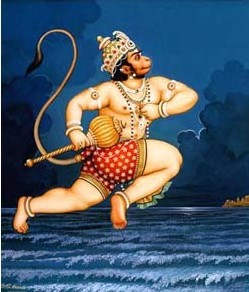
The Words of instruction of Sri Gaurasundar are verily His beautiful body; the preachers of His Word through the ages are His secondary limbs; the teaching of Sri Gaurasundar is His potent weapon; and the Grace of Sri Hari Himself established in the Word of Sri Chaitanya, is His eternal associate. Therefore, for the purpose of truly presenting Sri Gaurasundar, the Lord of the Gaudiya, to the aliens, I am addressing these few words of mine to the preachers who are about to proceed to countries beyond India.
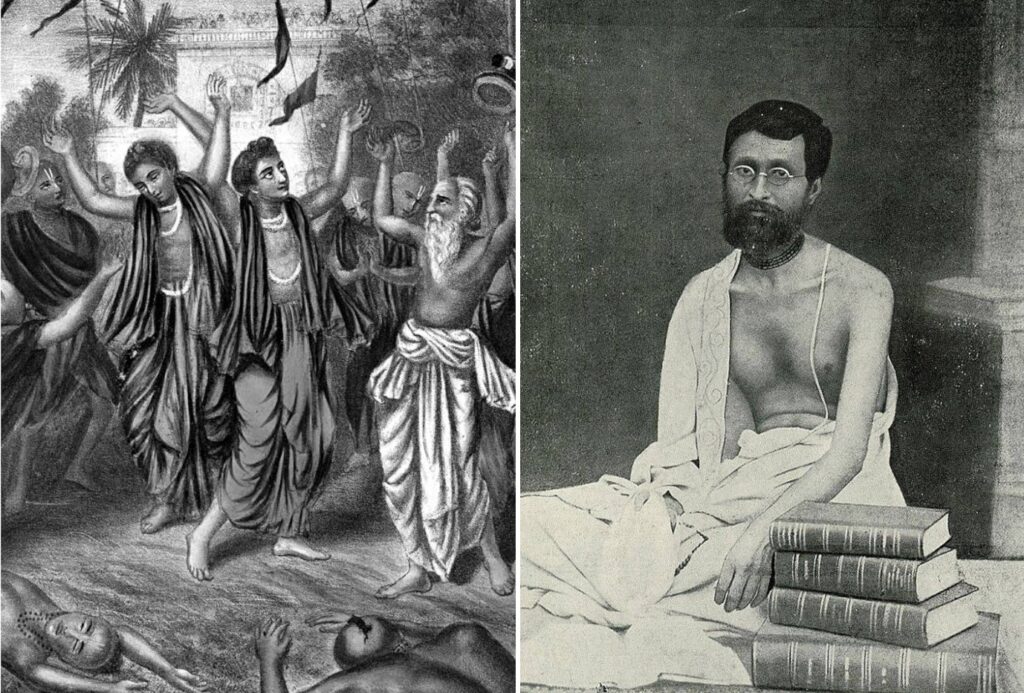
We find the following great precepts (Mahavakya) in the body of the Teaching that has been vouchsafed to us by the Supreme Master of all Masters:
To chant constantly the discourse of Hari by being (1) extremely more humble than the blade of grass, (2) by being as forbearing as the tree, (3) by seeking no honour for oneself and (4) by offering due honour to all entities, is the highest natural function of the unalloyed individual souls (Jivas).
The lotus-feet of my Sri Guru-deva attracted me to his service by his manifestation as the living embodiment of these four great precepts. My friends (his disciples) will be in a position to attract all souls of the world to the foot-stool of the Real Truth by purchasing the same unfailing method.
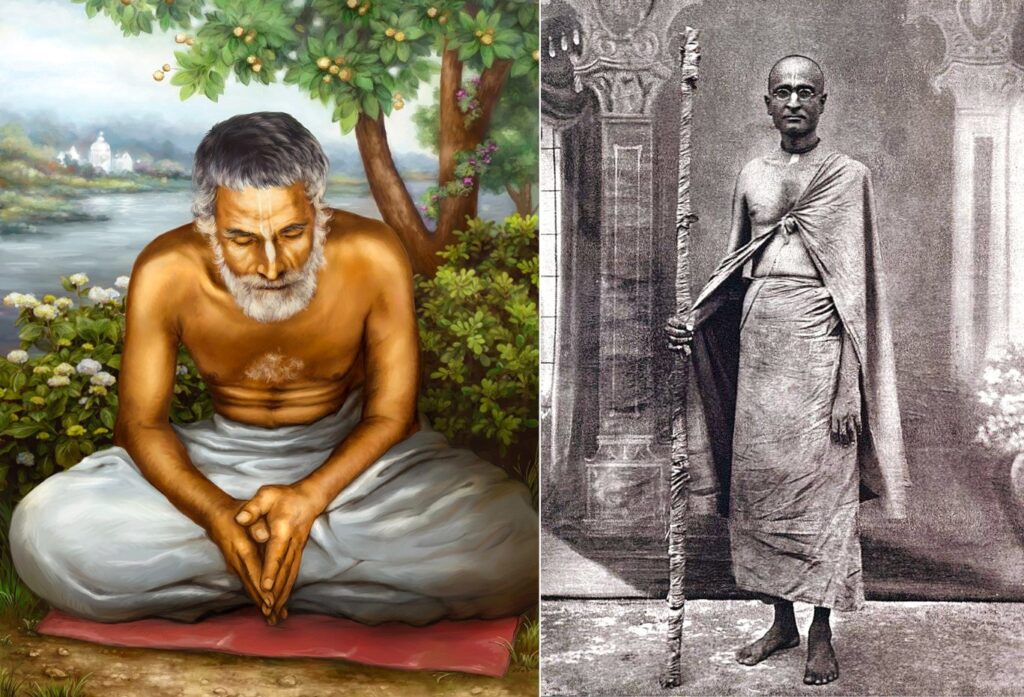
Gaurakisora Das Babaji and Bhaktisiddhanta Sarasvati
… Sri Krishna Chaitanya Deva is the Supreme Teacher of all teachers of this world and the ideal possessor of intelligence that is the highest of all. It should be our only duty to constantly chant those words regarding the cleansing of the mirror of the heart of which He speaks in His Eight Precepts (Sikshastakam). We are only the bearers of the Transcendental Word. We shall never in any way hesitate to offer every honour and facility, for which they are eligible, to all persons of this world. We must pray to all for the boon of aptitude for the service of Krishna.
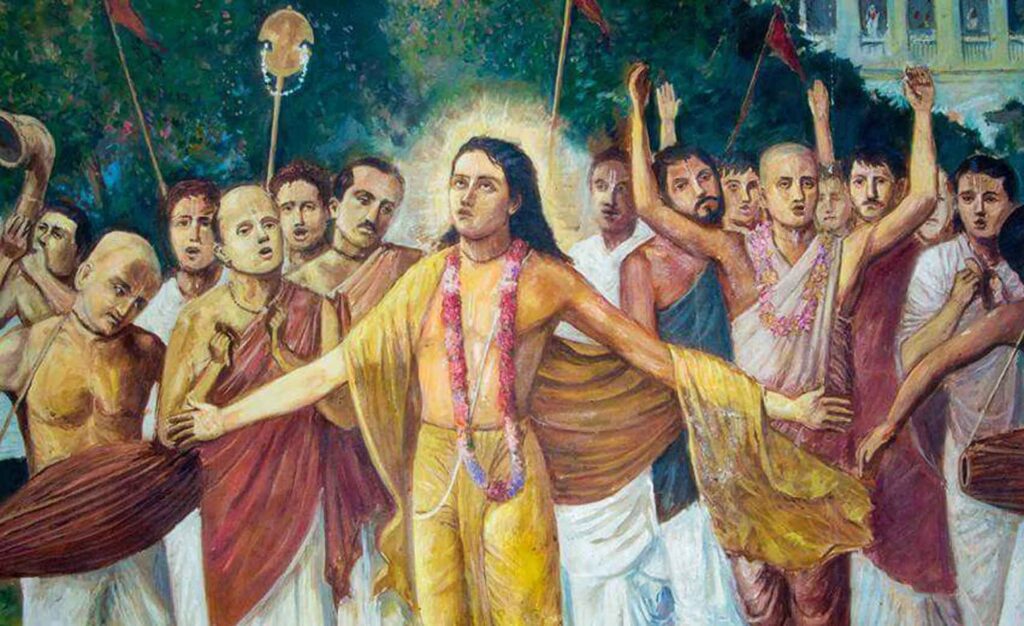
We shall come across many persons in this world, possessing an endless variety of characters, disposed or hostile to the service of Krishna. But we should not slacken in our loving service of the Lord of our hearts and should offer due honour to all persons. We will have opportunities, as we approach different persons in all parts of the world with the vendor’s bag of the discourse of Hari, to see a good many sights, to hear much and to seek to derive much benefit from our experience. May we never forget that all entities of this world are essentially proteges of the Lotus-feet of Sri Guru for helping the expansion of His service. May we always remember that they are excellent only if they are prepared to wait with the utmost eagerness on the particle of dust of the lotus-feet of my Sri Guru and that otherwise they are merely the mirage devised by the deluding potency for our ruin.
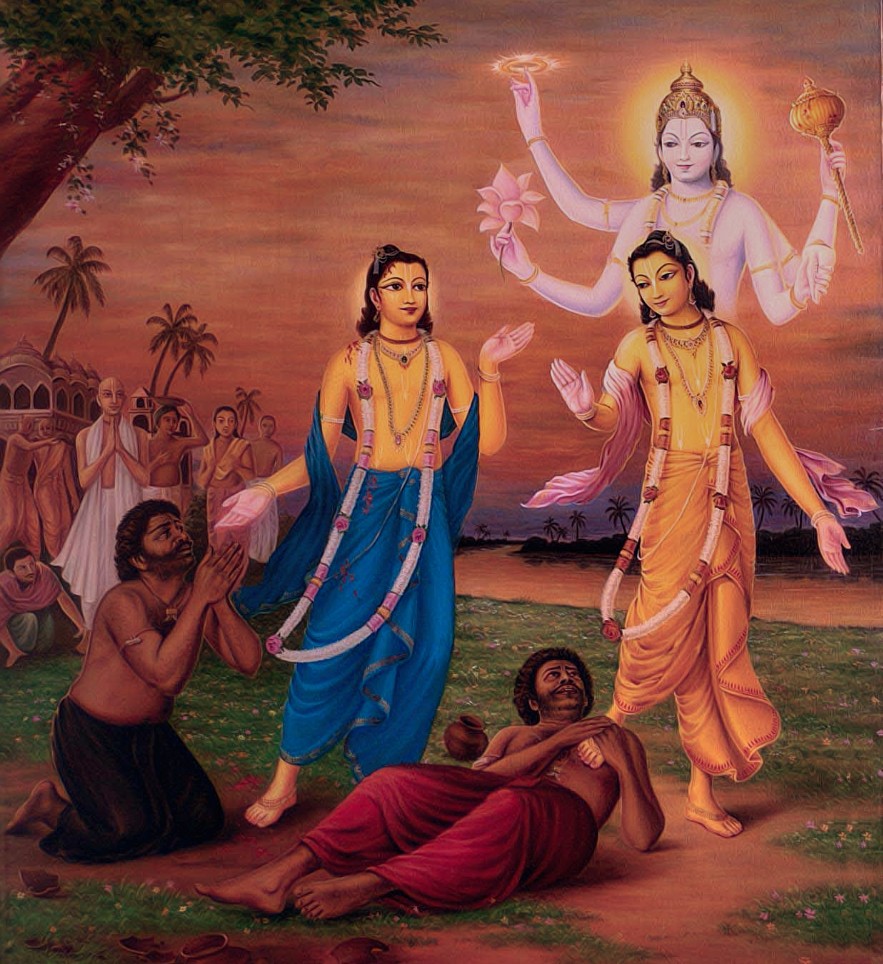
Jagai and Madhai receiving the mercy of Nitai-Gaur
… Those nations to whom you are going for the propagation of the chant of Hari are mounted on the summit of proficiency in all affairs of this world. … If we unpack our baggage of the genuine discourse of Hari by relying on the qualities of forbearance it will certainly receive the garland of welcome from the hearts of nations gifted with keen intelligence. … We should call at the door of each and every seeker of the Truth, bearing on our heads the baggage of the Real Truth to be offered to them. It is no business of ours to be elated or discouraged by the praise or neglect of any person. We must be constantly alive to the duty of enhancing the pleasure of our Master by serving Him with perfect sincerity. All persons of this world are really superior to us in every way as far as this world is concerned. All those matters are not any commodities that are fit to be coveted by us. We are merely beggars with the triple-staff of renunciation devoted to the chanting of the Words of Sri Chaitanya. We have no more nor any higher desirable object than the Pleasure of serving Sri Hari, Guru and Vaisnavas.
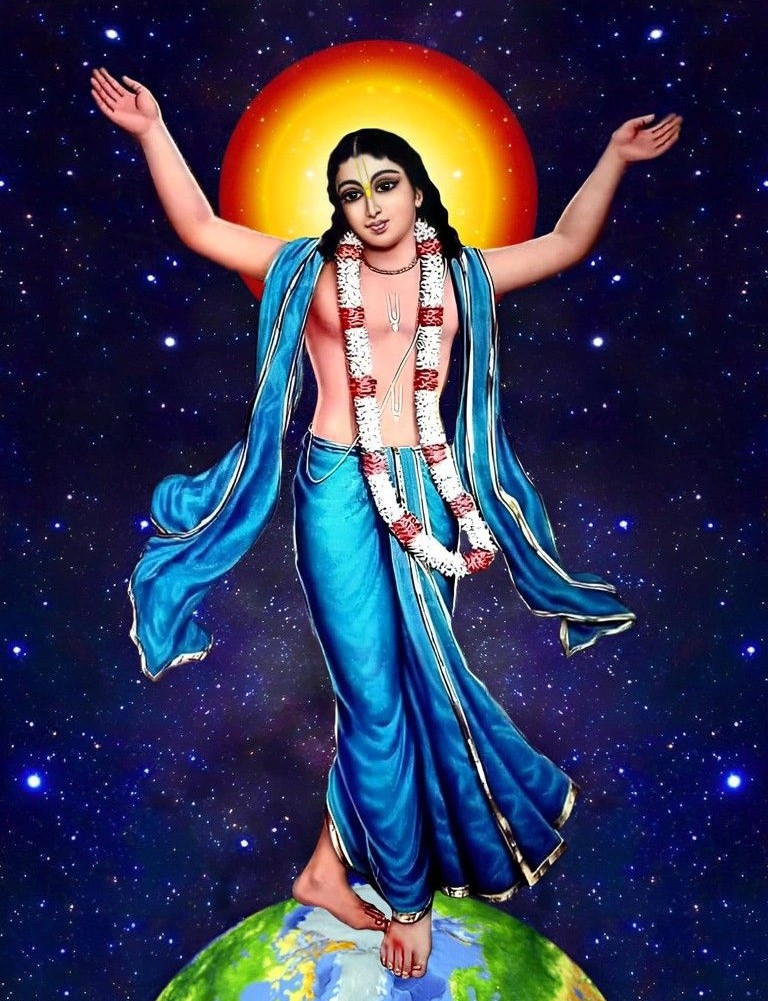
We are not the operators of the instrument, but only the instruments. We must always bear this in mind. … We must always bear in mind that we have been initiated in the vow of the peripatetic (itinerant or wandering) preacher for the sole purpose of promulgating the Heart’s Desire of Sri Guru and Gauranga. … It will be our only duty, to proclaim to all the people that complete reliance on the Transcendental Absolute Truth is by far the highest form of freedom and one that is Infinitely superior to the partial independent mastery over the distorted reflected entity in the shape of this mundane world. By holding the straw (of humility) between our teeth in supplication we shall carry aloft the banner of that real freedom to all persons. We should be constantly engaged in chanting the exhilarating Name of Sri Hari by adopting as our fundamental enlightening principle that the highest path is the path of submission, endorsed by Sri Rupa with the further exhortation to cherish the unwavering faith that He will always protect us.
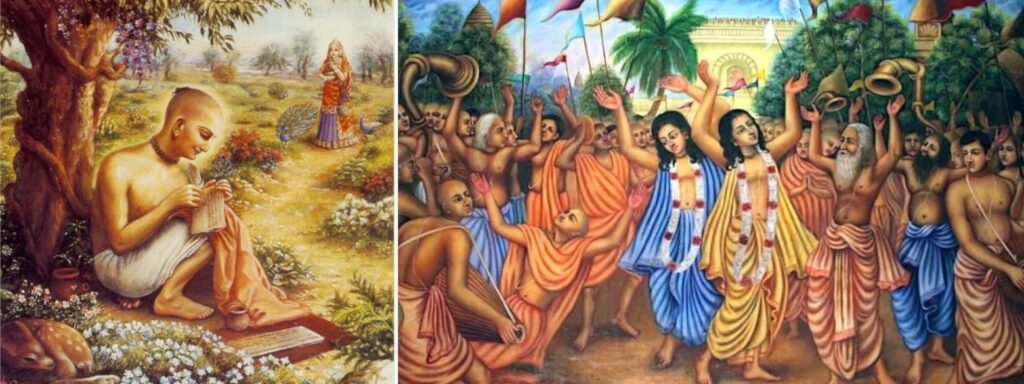
Srila Rupa Goswami and Lord Chaitanya’s Sankirtan Movement
Hearing Srila Bhaktisiddhanta’s L’Envoi, we can clearly see that Srila Bhaktivedanta Swami Prabhupad’s mood, words and activity were the living personification of a true preacher, as described by his spiritual master. Srila Bhaktivedanta Swami was undoubtedly the full manifestation of the intense desire of Srila Sarasvati Thakur to spread Krishna consciousness in the Western world. He was consumed with the same intense compassion and humility to deliver the unfortunate suffering souls. These two liberated and empowered preachers were clearly chosen by Krishna for the salvation of the earth.
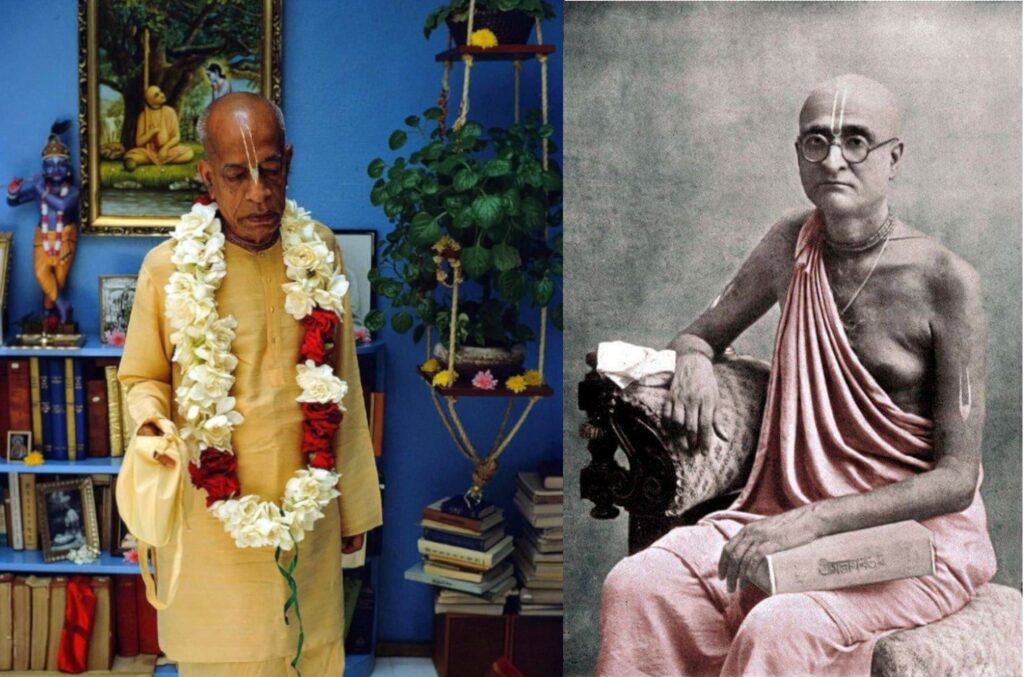
On August 27th of 1933, the appearance Day of Srila Bhaktivinoda Thakur, Srila Bhaktisiddhanta Sarasvati Thakur delivered a lecture at the Saraswati Assembly Hall in the Baghbazar temple of the Gaudiya Math. This lecture was printed in many Gaudiya publications and widely distributed. The title of the discourse was The Vedanta, Its Morphology and Ontology. The language of the essay was so erudite and complex that many scholars and intellectuals are still intrigued and baffled simultaneously by it (including myself). Not that Srila Sarasvati Thakur was being deliberately confusing, but some of the thoughts of such a transcendental genius can be very hard to follow. The essay is beyond brilliance and beyond scholarship, being perfect spiritual knowledge. We reproduce here a couple of the easier portions:
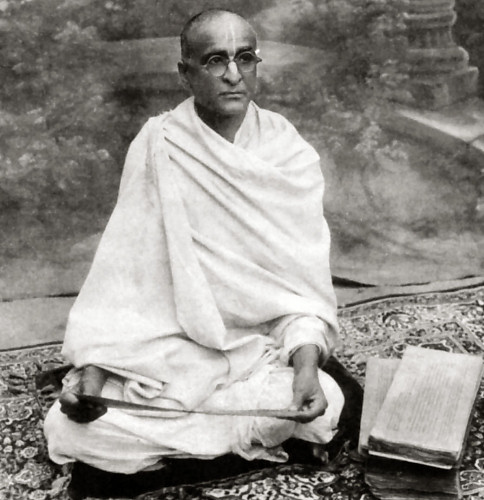
The Vedanta deals with a theme beyond the finite views of phenomena. The subjects dealt with in that particular philosophy are not confined to any part of the material space, any definite span of time or any object of sensuous perception made up of any substance of this Universe. The activities of a being are measured in time, the playground of a being either linear, superficial or cubical is accommodated in space and the limited subjectivity or fleshy tabernacular entity is confined to phenomenon. The Vedantic scheme is quite different from such limited structural monuments, though some people attempted to bring Vedanta within the prison bars of their senses.
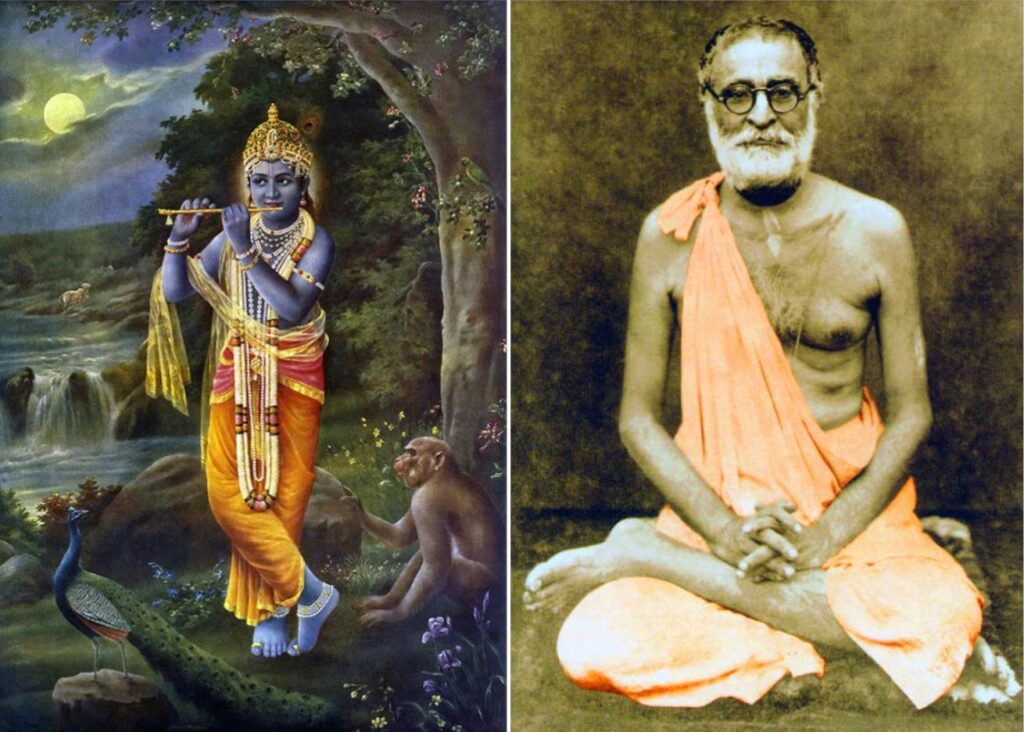
Though Vedanta deals with ordinary language quite dovetailing the views of ordinary intelligentsia to gradually heave them up to the supersensuous regions where senses cannot work by their present implements or cannot help them by the words of their credulous friends, still the transcendental topics are imparted slowly through the linguistic and rationalistic attainments to differentiate the plane of transcendence and the undesirable transformable plane of enjoyments. As it is helping the journey of understanding, we need not stick to a stagnant view in order to gratify our senses at cost of rationality and harmonious language exactly fitting our whims. So the method of studying this particular philosophy should never be confined to the same process of confusing the transcendence with our present plane of thought.
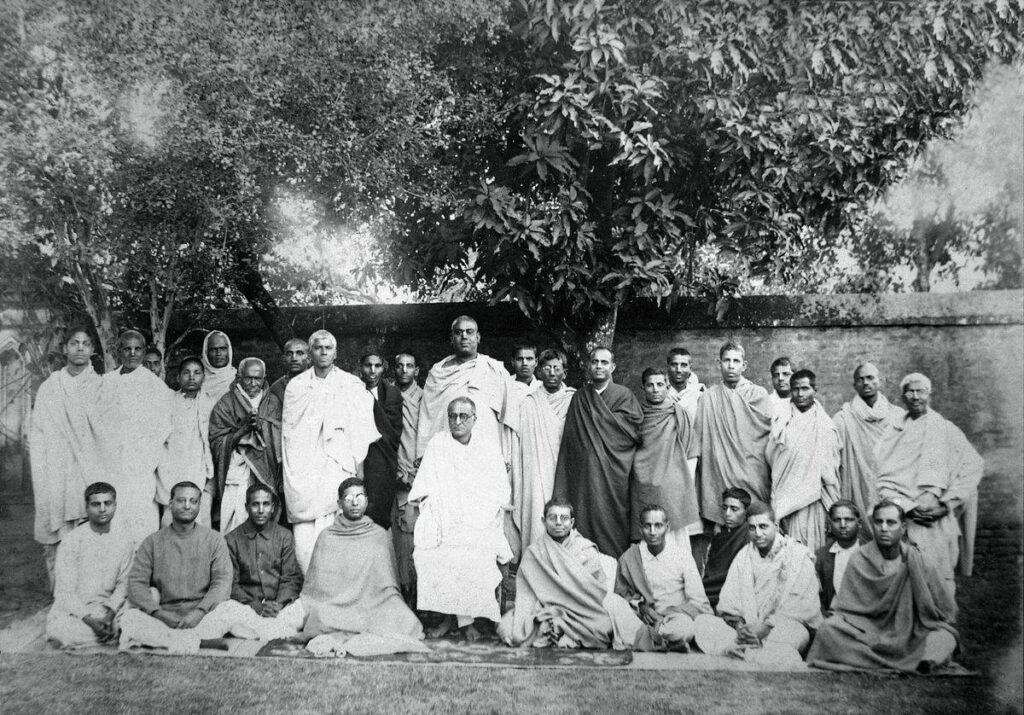
In August of 1933, the second annual diorama exhibition was held in Kuruksetra and was called the Gaudiya Exhibition. In September of 1933 Srila Sarasvati Thakur went on a sankirtan tour with his disciples, preaching and chanting in different places around Navadvipa, utilizing two motor launches called “Leela” and “Suradham.” Towards the end of the year he preached in Patna, where he opened another diorama exhibition, again called Sat-siksha, and many eminent persons from Patna University attended. At the end of November he published his edited edition of Srila Jiva Gosvami’s Bhakti Sandarbha. Other preachers went to Karachi and simultaneously a theistic exhibition was organized in Kasi (Benares).
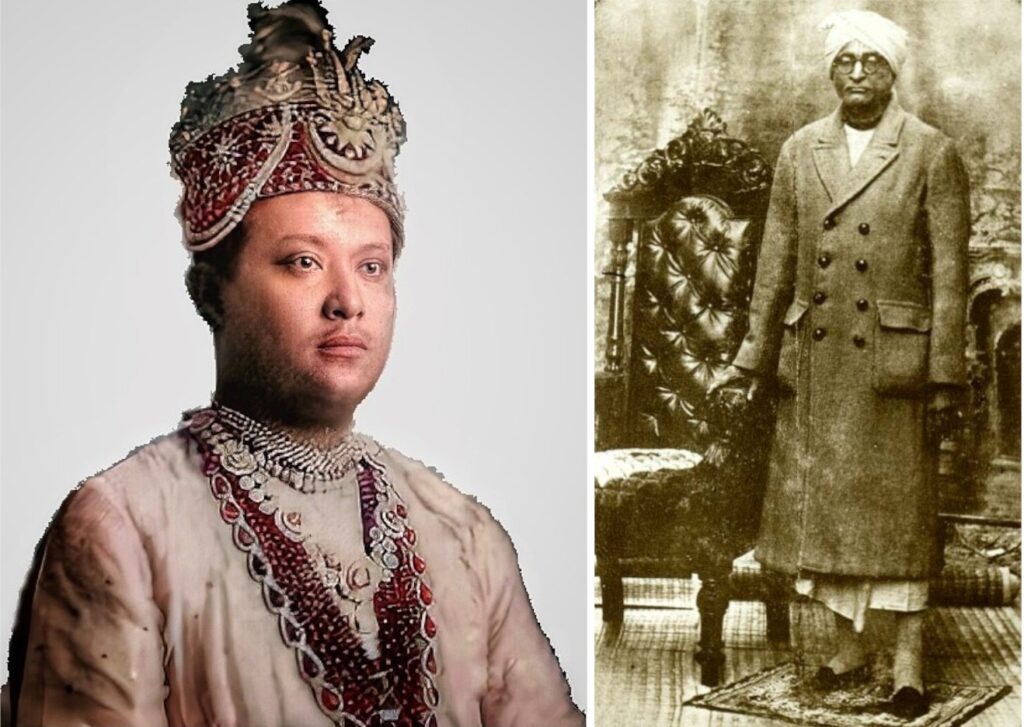
The Maharaja of Tripura and Srila Bhaktisiddhanta Sarasvati Thakur
In the beginning of 1934 the Maharaja of Tripura visited Srila Bhaktisiddhanta Sarasvati Thakur in Calcutta and praised the programs of the Gaudiya Mission. He offered his respects to the feet of Srila Bhaktisiddhanta Sarasvati Thakur, inquired from him on spiritual topics and heard from him attentively. In February he inaugurated a newly built temple at the birthsite of Srila Vrindavan Das Thakur, at Modadruma-dvipa in Navadvipa-dhama. Srila Vrindavan Das Thakur, called “the Vyasa of Caitanya-lila,” was the author of Lord Chaitanya’s biography, Sri Chaitanya-bhagavata. When Lord Chaitanya ended His pastimes on the planet, Srila Vrindavan Das Thakur was 20 years old. Lord Nityananda initiated him and instructed him to write the glories of Lord Chaitanya. It is said in the Caitanya-caritamrita:
Vrindavan Das Ṭhakur is Lord Nityananda’s favorite devotee, and therefore he is the original Vyasadeva in describing the pastimes of SrI Caitanya Mahaprabhu.
[Caitanya-caritamrita, Antya lila 20:8]
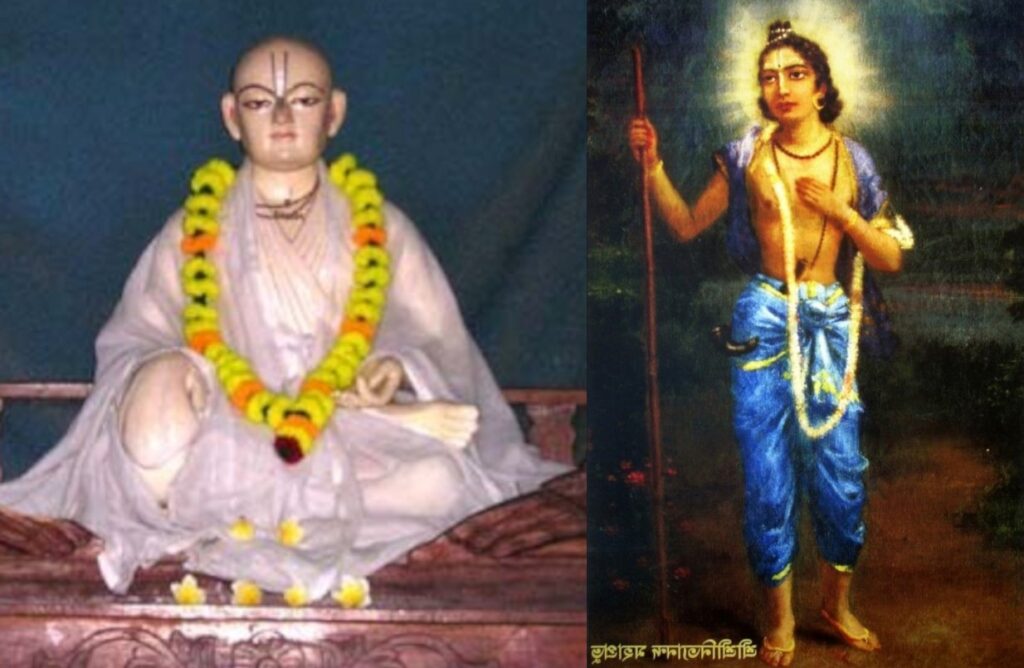
Deity form of Vrindavan Das Thakur and Lord Nityananda
Srila Bhaktisiddhanta Sarasvati also opened a temple at Srivasa Angana, the place of Lord Chaitanya’s inauguration of the Sankirtan Movement, as well as His nocturnal kirtans with His eternal associates. This place is also known as Khola Bhanga Danga, the place where Chand Kazi’s men broke a mridanga drum while harassing the Lord’s sankirtan party. The newly constructed samadhi of his spiritual master, Srila Gaurakisora Das Babaji was also completed and opened at this time. During the course of the year, he engaged in discourses with many scholars, government leaders and religionists, and he initiated a good number of his followers into the sannyas order.
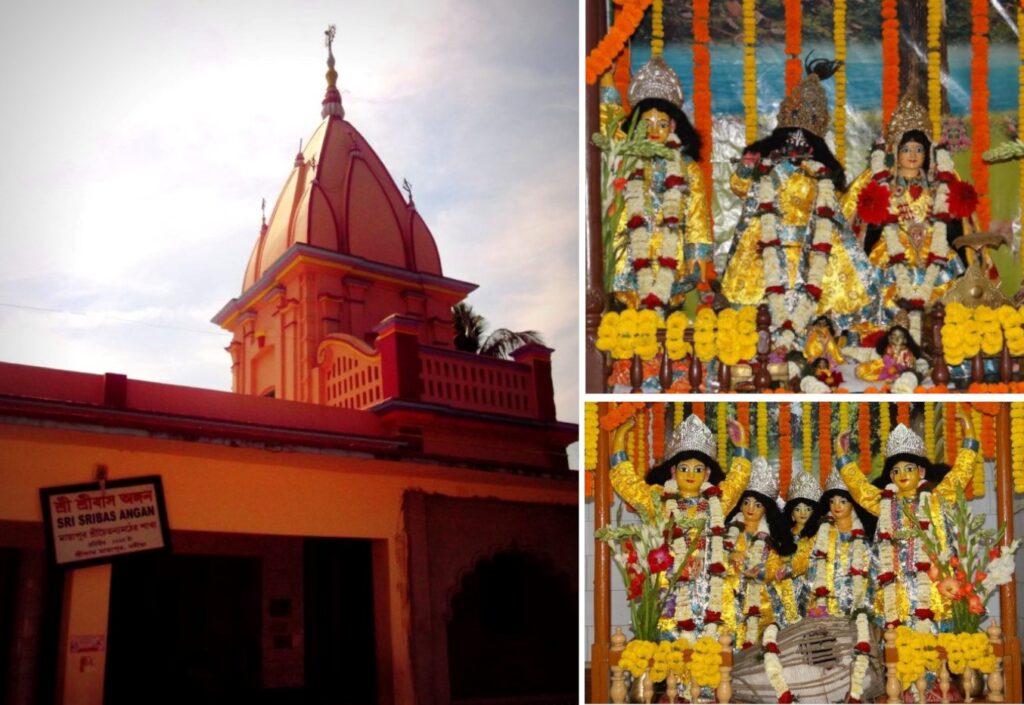
Temple at Srivasa Angana and Deities [bottom pic shows the broken mridanga drum]
On June 13th of 1934, while the foundation of the Mayapur Yogapitha Temple was being dug, a four-armed Adhoksaja Deity was discovered and identified as the household Deity of Jagannath Misra, the father of Lord Chaitanya. Everyone on hand was amazed and excited at this event, which only further confirmed the absolute authenticity of the site discovered by Srila Bhaktivinoda Thakur.
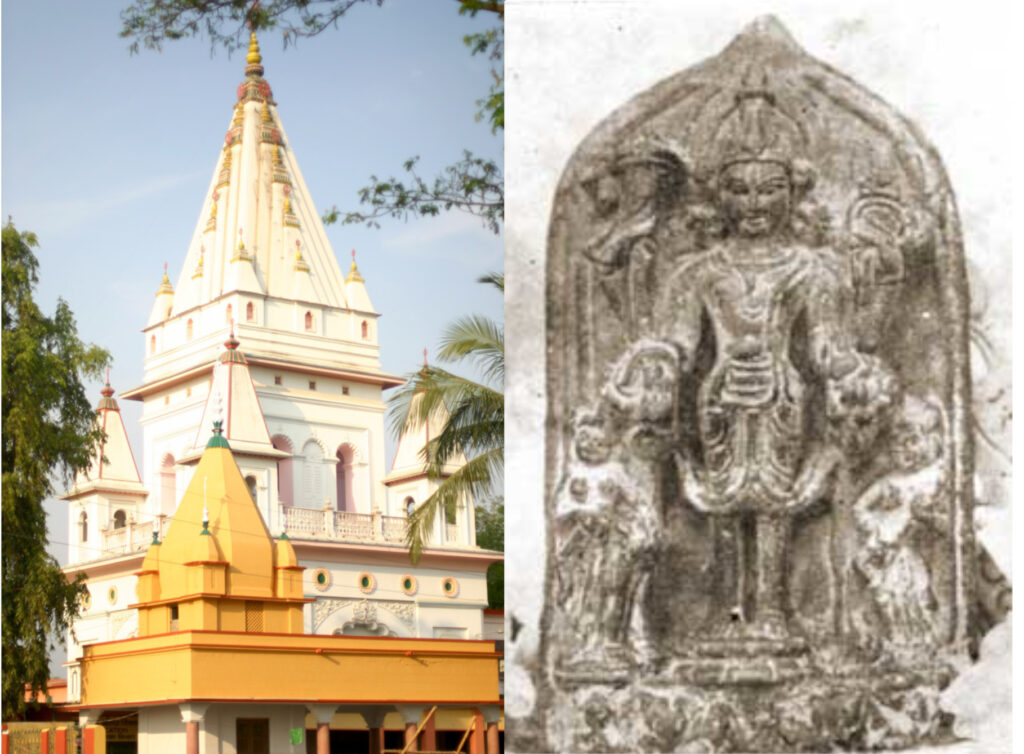
Mayapur Yogapitha Temple and Adhoksaja Deity
In July the deity form of Srila Gaurakisora Das Babaji was installed in his samadhi temple accompanied by tremendous sankirtan. In October (1934) Srila Sarasvati Thakur and many disciples stayed in Mathura for more than a month, strictly executing the Karttika vow. During this time, he spoke on the topics of Krishna’s asta-kaliya-lila (the pastimes of the Lord executed during the day’s eight divisions.) On the 29th of October, Srila Bhaktisiddhanta Sarasvati Thakur discovered the actual site where Srila Rupa Gosvami had the darsan of the Gopala Deity in his old age in the Mathura area.
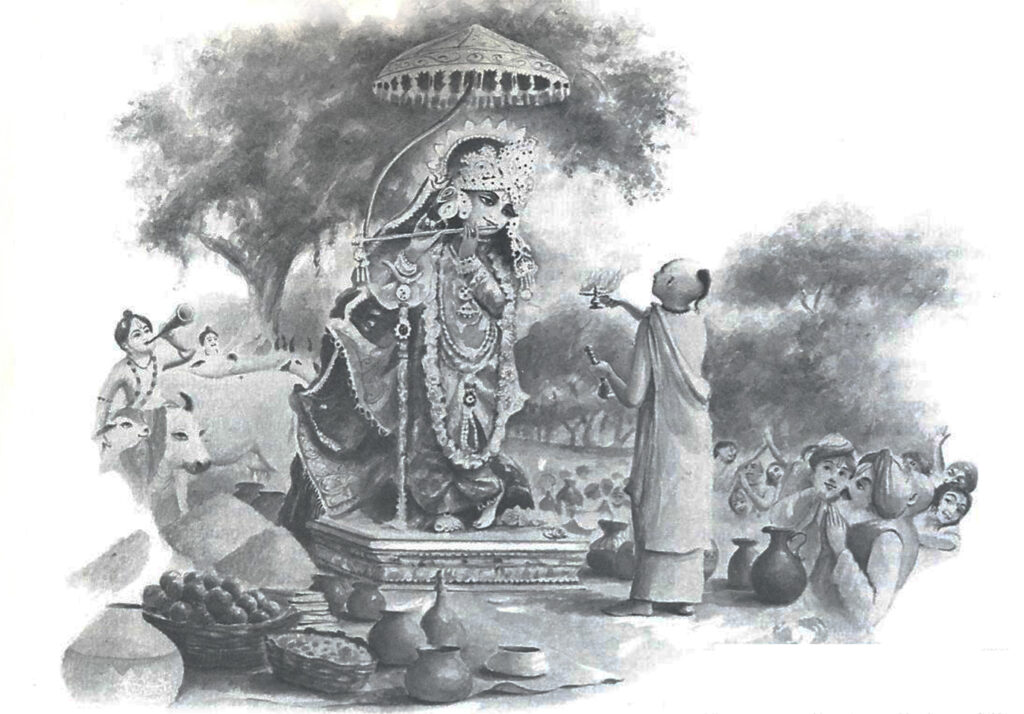
Madhavendra Puri worships the Gopala Deity
This Deity of Gopala has a great history. He was originally established by Vajra, the grandson of Lord Krishna. Later, during the Mohammedan era, there was threat of attack and the priest hid Gopala in the bushes and ran away. When Madhavendra Puri – the guru of Ishvara Puri, Sri Chaitanya Mahaprabhu’s spiritual master – came to Vrindavan, Gopala appeared to him in a dream, told him of his location, and asked him to install him once again on the top of Govardhan Hill. Madhavendra Puri built a temple, held a magnificent installation ceremony with hundreds of buckets of water and mountains of prasadam, and established a very high standard of Deity worship.
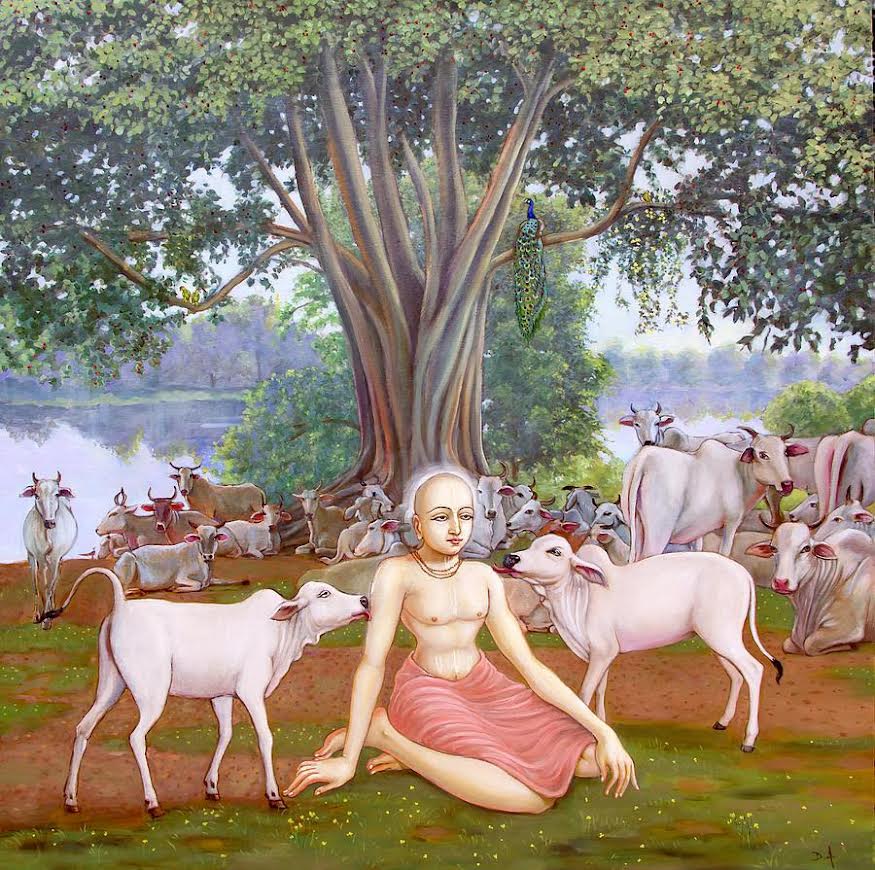
Lord Chaitanya in Vrindavan
When Sri Chaitanya Mahaprabhu came to Vrindavan, in the mood of a humble devotee, He did not want to put His feet on Govardhana Hill (as it is non-different from Krishna). Therefore the Deity, on the pretext of an imminent attack by some Turkish soldiers, descended to the village of Ganthuligram and gave His darsan to (or took darsan of) the ecstatic Sri Chaitanya Mahaprabhu for three days. Later, Gopala returned to His place on Govardhana Hill.
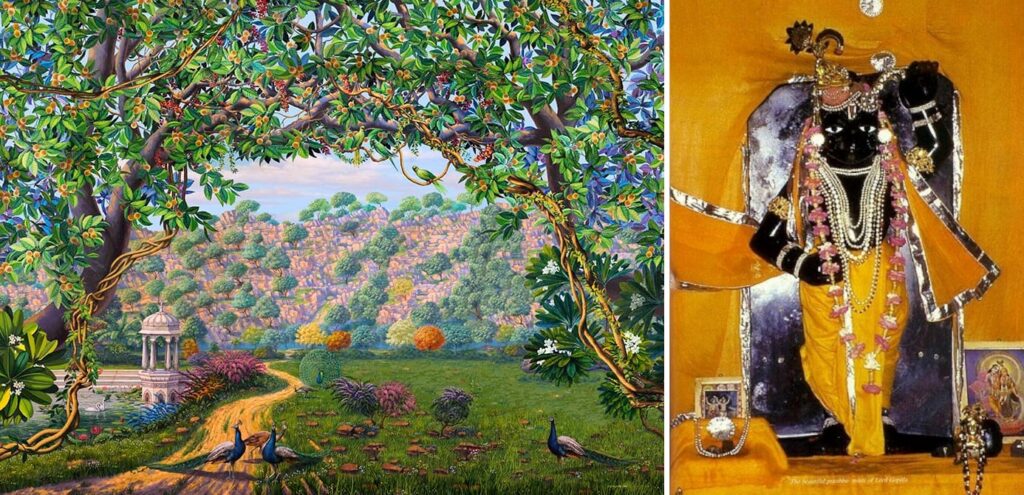
Govardhan Hill and Gopala Deity [now called Sri Nathji]
In their old age, Srila Rupa Gosvami and Srila Sanatan Gosvami also wanted to receive the darsan of Lord Gopala, but following in the footsteps of Sri Chaitanya Mahaprabhu they did not want to step on Govardhana Hill. Therefore, the Deity made an arrangement for them as well, by descending to Mathura and staying in the temple of Vitthalesvara for one full month. A huge procession of spiritual luminaries accompanied Srila Rupa and Srila Sanatan Gosvamis to Mathura and stayed with them there. Gopala Bhatta Gosvami, Raghunath Das Gosvami, Raghunath Bhatta Gosvami, Lokanath Das Gosvami, Bhugarbha Gosvami, Srila Jiva Gosvami, Sri Yadava Acharya, and many other exalted Vaisnavas were all present.
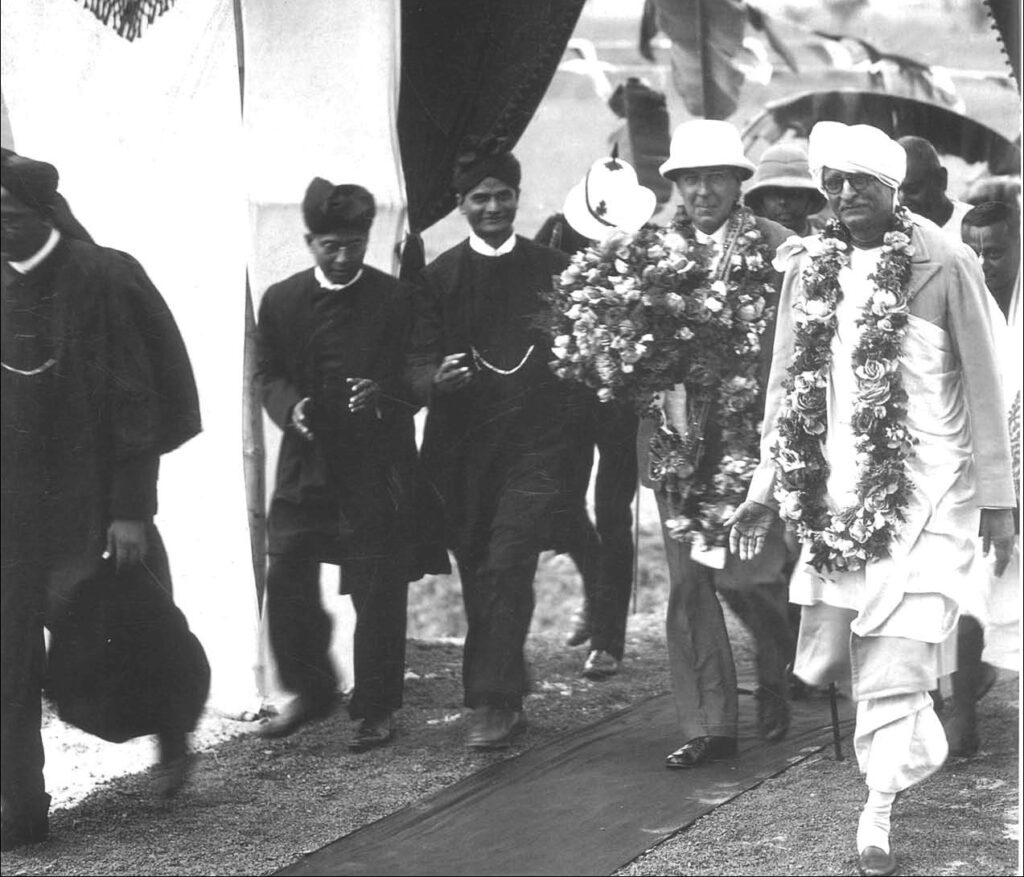
Governor of Bengal, Sir John Anderson with Srila Bhaktisiddhanta Sarasvati Thakur
Toward the end of 1934 Srila Bhaktisiddhanta Sarasvati Thakura directed his European preachers to deliver lectures in the German universities, where there was much interest in Sanskrit and Vedic culture. In January of 1935 the Governor of Bengal, Sir John Anderson, came to Mayapur and heard about the Holy Dhama from Srila Bhaktisiddhanta Sarasvati Thakur.
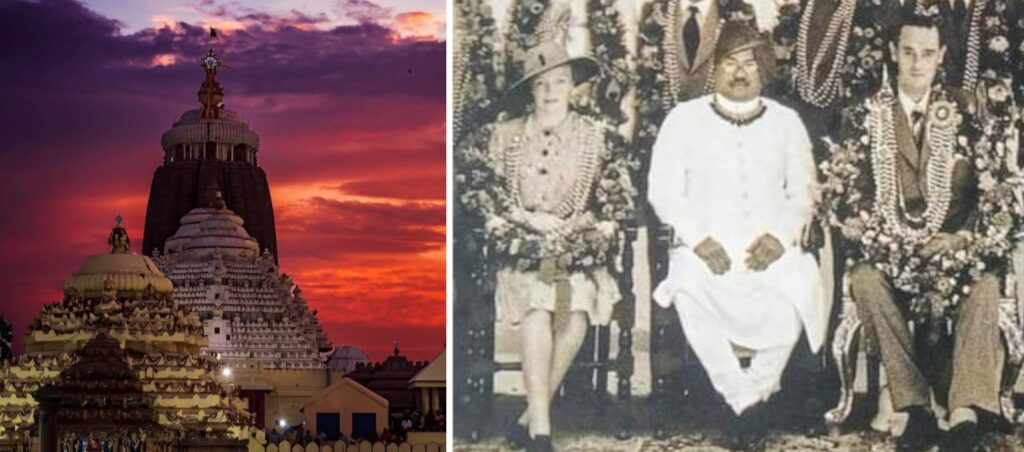
Jagannath Temple and the King of Jagannath Puri [middle]
In February (1935) the 61st birthday of Srila Bhaktisiddhanta Sarasvati Thakur was celebrated in Jagannath Puri, the place of his appearance, and a large meeting was convened, chaired by the king of Jagannath Puri. That was the year that Srila Bhaktivedanta Swami Prabhupad composed a Vyasa Puja poem and essay, which he submitted to the Harmonist for publication. In the poem, Srila Bhaktivedanta Swami coined the phrase “His Divine Grace” to describe his spiritual master as the embodiment of Lord Krishna’s mercy. This title was later adopted by Srila Bhaktivedanta Swami’s own disciples to glorify their spiritual master:
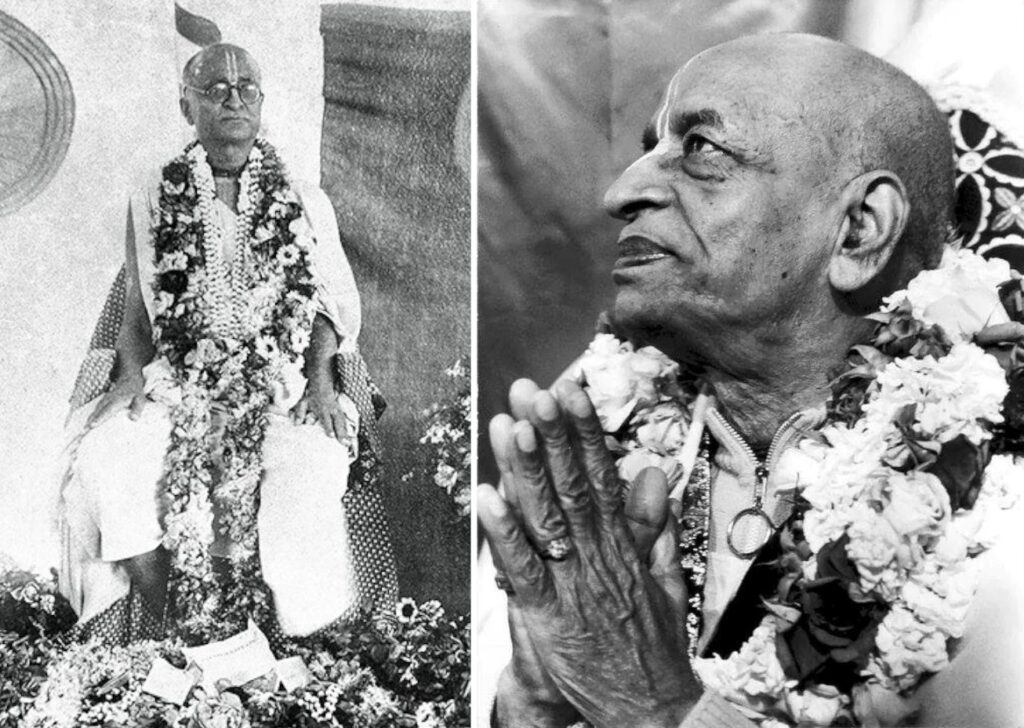
1
Adore, adore ye all the happy day
Blessed than heaven, sweeter than May.
When he appeared at Puri, the holy place
My Lord and Master, His Divine Grace.
2
Oh my Master, the evangelic angel
Give us thy light – light up thy candle.
Struggle for existence, a human race
The only hope: His Divine Grace.
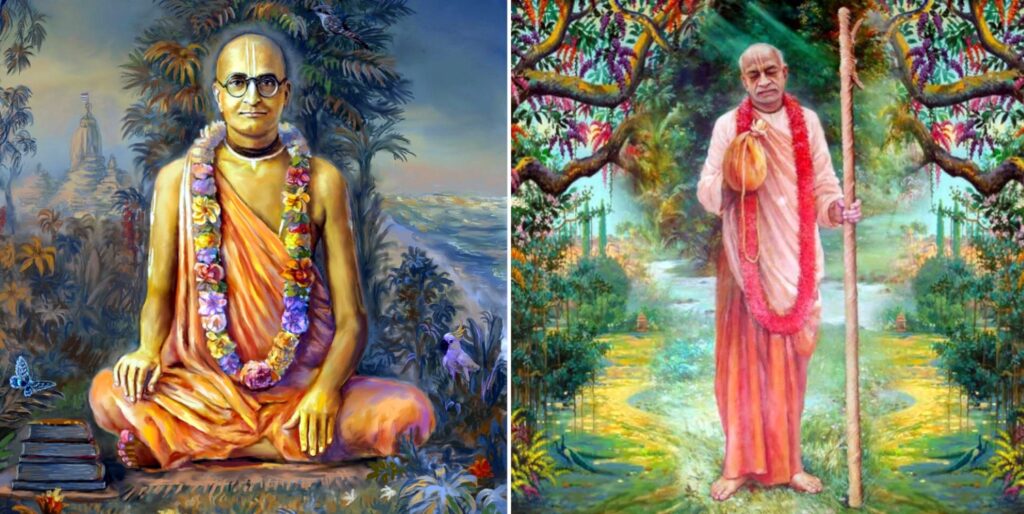
3
Misled we are, all going astray
Save us Lord: our fervent pray.
Wonder thy ways to turn our face
Adore thy feet, Your Divine Grace.
4
Forgotten Krishna, we fallen souls
Paying most heavy the illusion’s toll.
Darkness around, all untrace
The only hope: His Divine Grace.
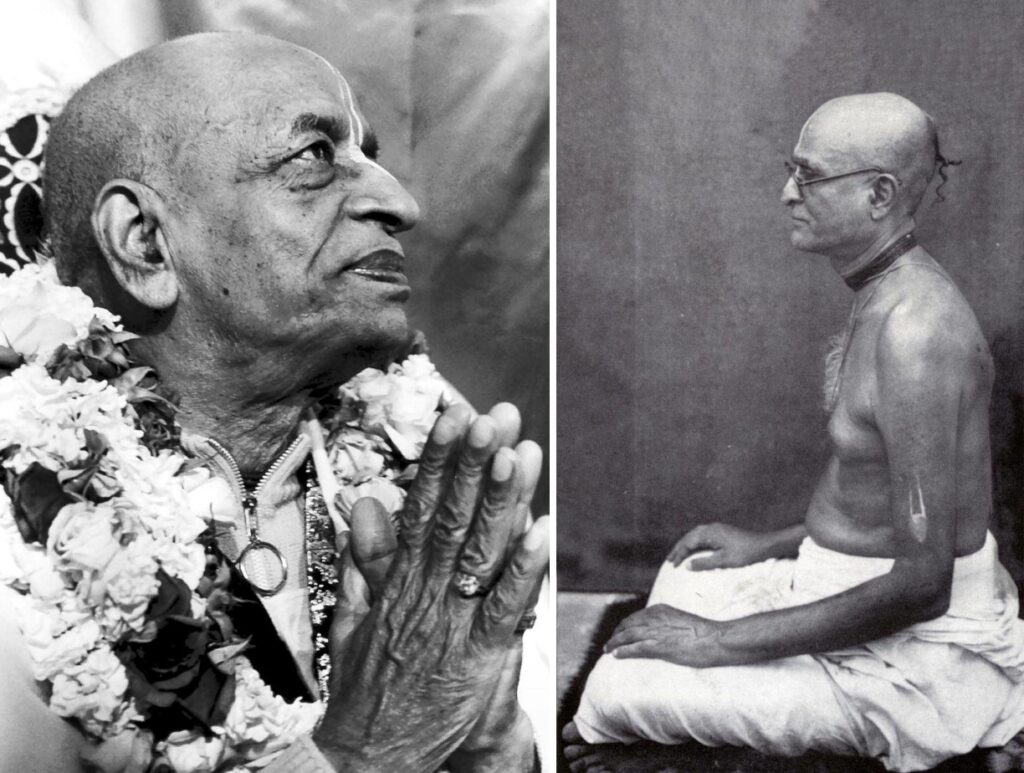
5
Message of service thou hast brought
A healthful life as Chaitanya wrought.
Unknown to all, it’s full of brace:
That’s your gift, Your Divine Grace.
6
Absolute is sentient thou hast proved
Impersonal calamity thou hast removed.
This gives us a life, anew and fresh:
Worship thy feet, Your Divine Grace.
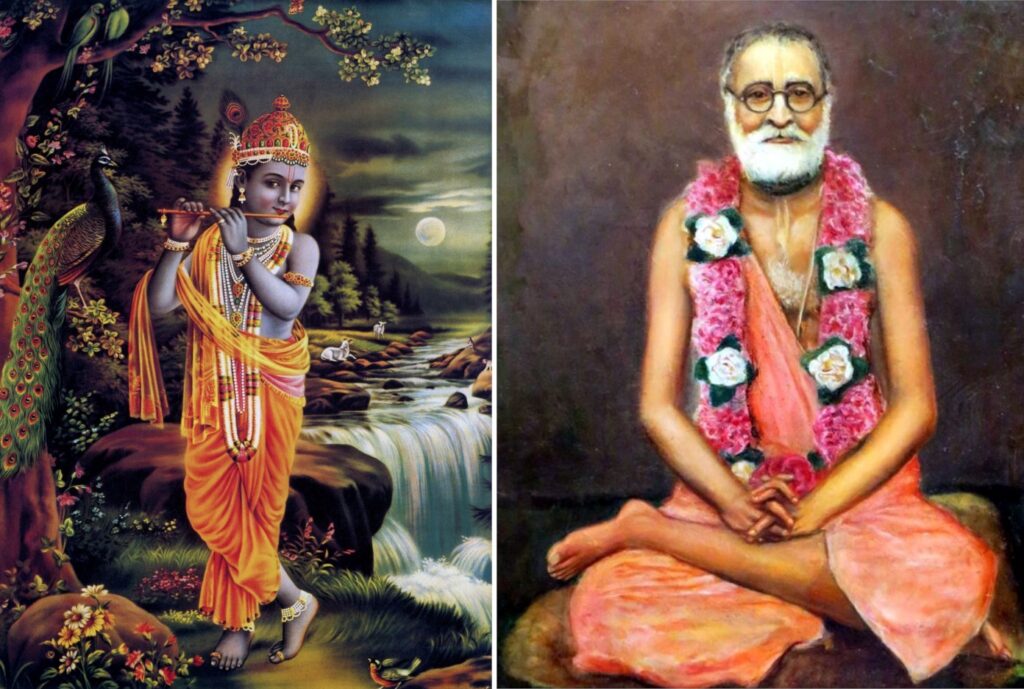
Srila Sarasvati Thakur very much appreciated both the poem and essay. He instructed the editor of The Harmonist, “Whatever he writes, publish it.” One stanza of the poem was particularly pleasing to Srila Bhaktisiddhanta Sarasvati Thakur, and he liked it so much he showed it to everyone who came to see him:
Absolute is sentient
Thou has proved,
Impersonal calamity
Thou hast removed.
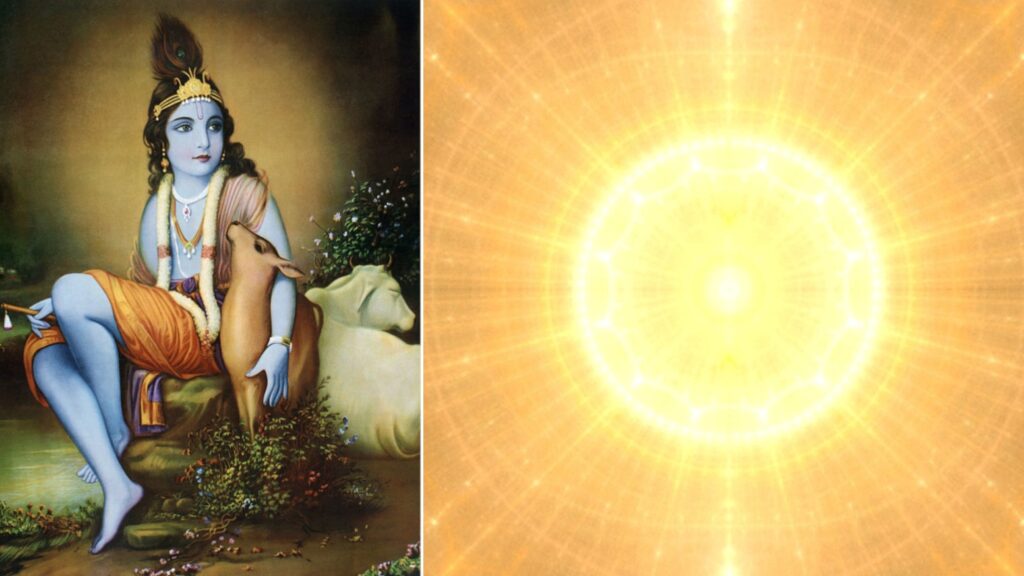
The Supreme Lord is a sentient person, not merely a formless ocean of light
On the day after the Vyasa Puja ceremony, Srila Bhaktisiddhanta Sarasvati Thakur led his followers on a circumambulation of Jagannath Puri, and spoke to them about its glories. On Gaura Purnima he was visited in Mayapur by the King of Tripura, who opened the gate of the Yogapitha Temple. In April he travelled to Gaya, where he opened a center, saw Sri Chaitanya Mahaprabhu’s places of preaching and gave wonderful lectures to a sophisticated and learned audience. To further spread the waves of Lord Caitanya’s mission, he sent preachers to Burma in the same month.
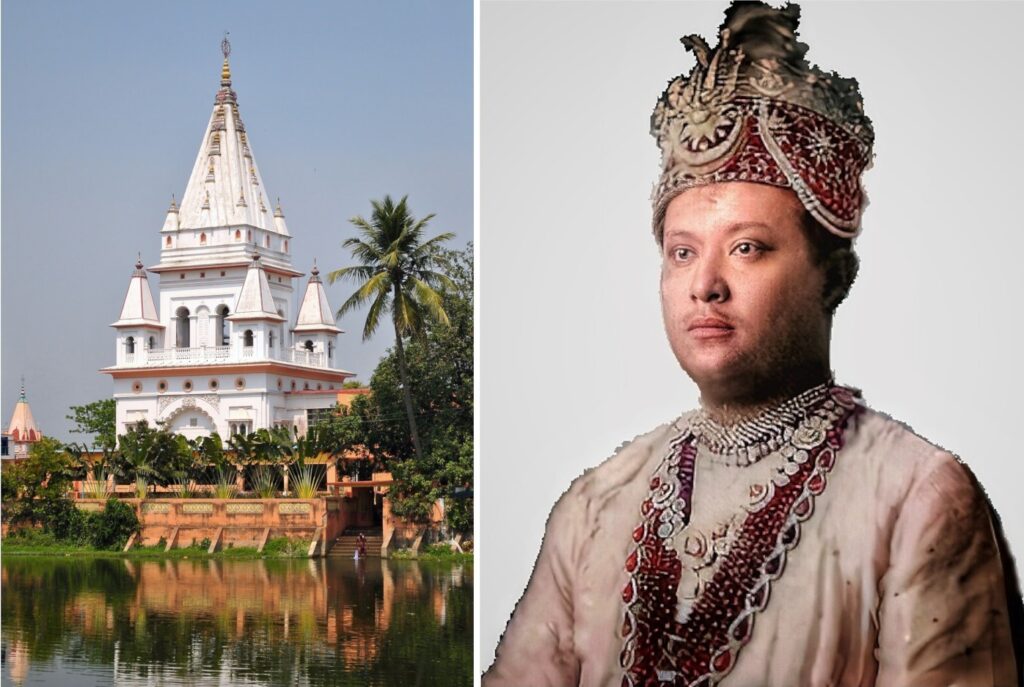
The Yogapitha Temple and the King of Tripura
In June of 1935 he broadcast, for perhaps the first time by radio, Hari Nama Sankirtan from the Indian Broadcasting Service Center in Calcutta. This led to regular Sunday broadcasts of various Gaudiya functions like live broadcasts of sankirtan and bhajans from different parts of Calcutta, the Janmastami celebration, Nanda-utsava, Radhastami and the Appearance Celebration of Srila Bhaktivinoda Thakur.
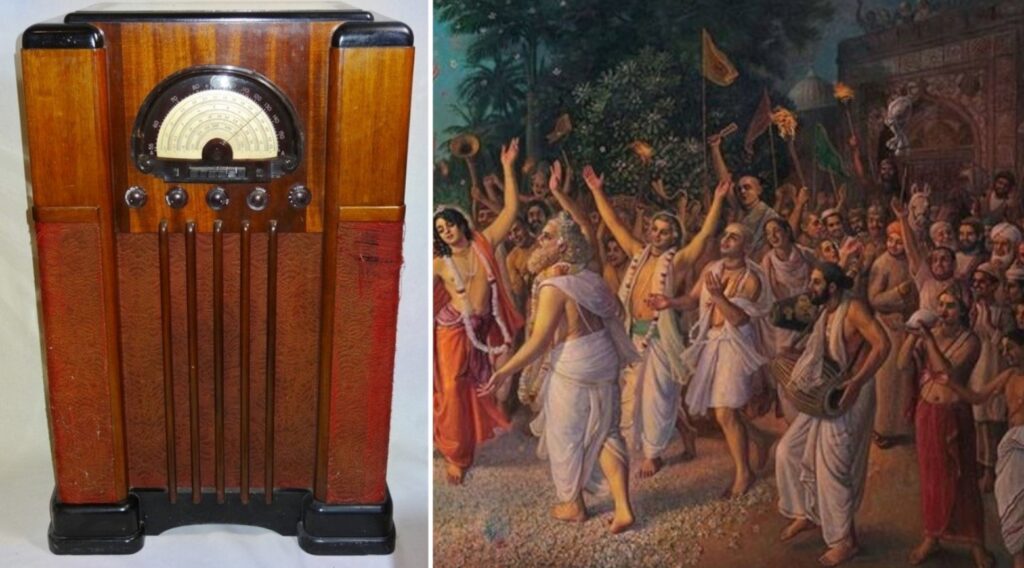
Hari Nama Sankirtan hits the radio
In September (1935) the complete edition of the Srimad Bhagavatam was published in 12 Cantos with elaborate indexes, word meanings, Bengali translation, Srila Visvanatha Cakravarti Thakur’s Saratha varsini commentary, Srila Madhvacarya’s purports and Srila Bhaktisiddhanta Sarasvati Thakur’s own Vivriti commentary. In October Srila Bhaktisiddhanta Sarasvati Thakur stayed at Radhakunda, Vrindavan, for one month and lived in a small one-storied house which Srila Bhaktivinoda Thakur had constructed. He spoke to the assembled devotees on the Upanisads, Caitanya-caritamrta, and Srimad Bhagavatam, and he installed Deities at the Kunja-behari Math at Radha-kunda.
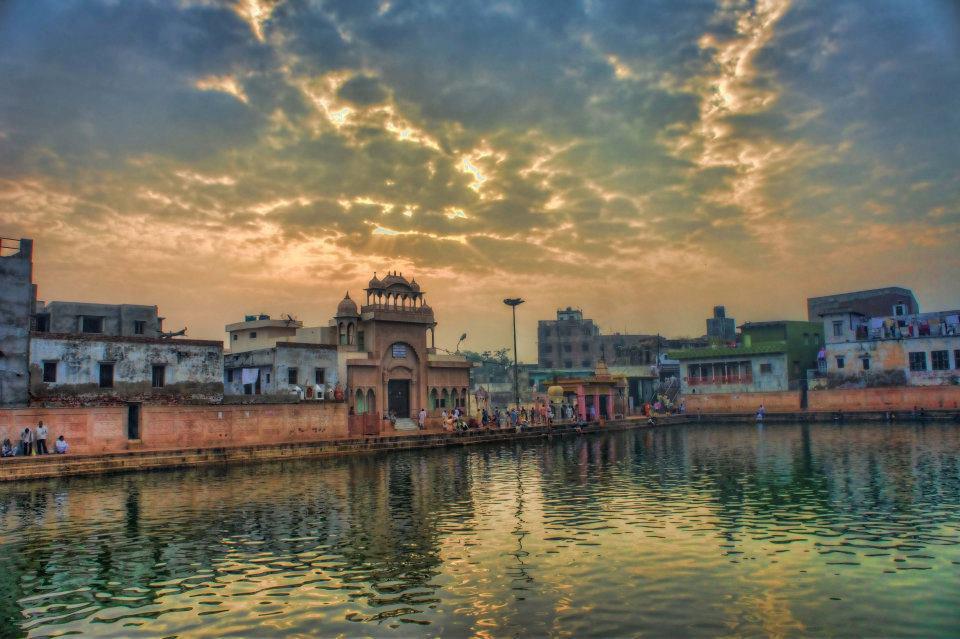
Radha-kunda, Vrindavan
At this time Srila Bhaktivedanta Swami Prabhupad met with Srila Bhaktisiddhanta Sarasvati Thakur and heard the prophetic comment:
Agun jvalbe: There will be fire.
This was in connection with the fighting over rooms which had broken out amongst Srila Bhaktisiddhanta Sarasvati Thakur’s disciples at the Baghbazar Gaudiya Math. The Thakur said:
When we were living in a rented house, if we could collect two hundred or three hundred rupees we were living very nicely at Ultadanga (Junction Road). We were happier then. But since we have been given this marble palace in Baghbazar, there is friction between our men. Who will occupy this room? Who will occupy that room? Who will be the proprietor of this room? Everyone is planning in different ways. It would be better to take the marble from the walls and secure money. If I could do this and print books, that would be better.
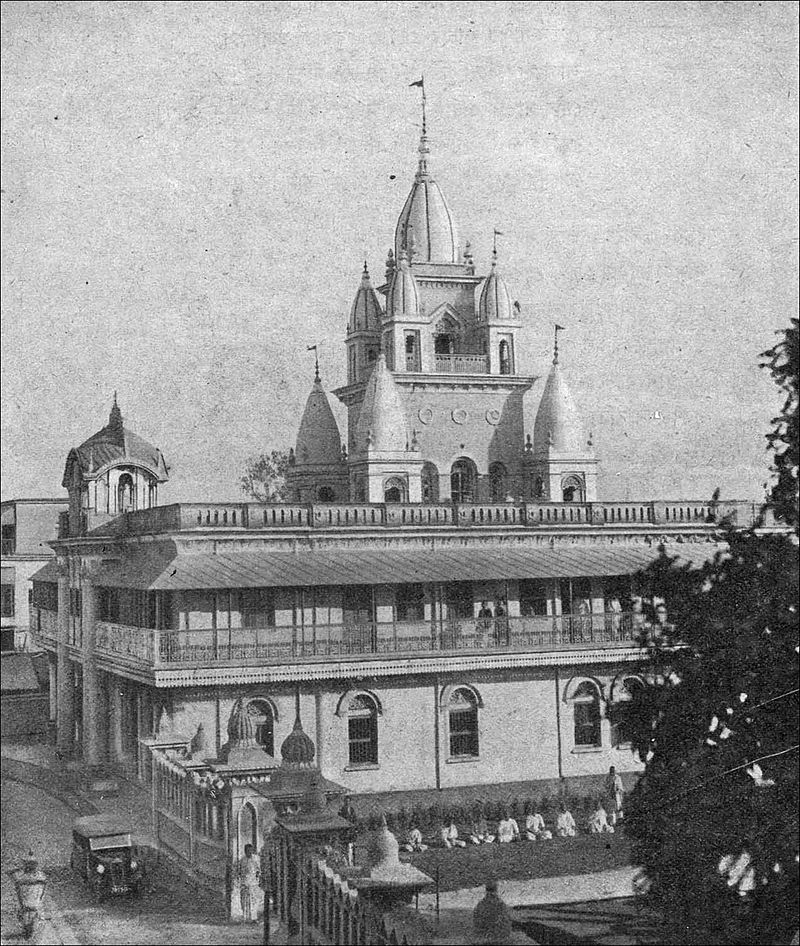
The Baghbazar Gaudiya Math Temple in Calcutta
Then he turned to Srila Bhaktivedanta Swami and said:
Amar iccha chila kichu bai karana: I had a desire to print some books. If you ever get money, print books.
Thus, important seeds were planted in the mind of Srila Bhaktivedanta Swami. On November 6 1935, Srila Bhaktisiddhanta Sarasvati Thakur established a puspa samadhi for Srila Bhaktivinoda Thakura at Kunja-bihari Math in Radha-kunda, and following this, he preached in Delhi and Gaya. News came regarding preaching successes in Burma and notable discussions were held with a number of western scholars. In December he went to Patna and Allahabad, and in Allahabad delivered discourses on the instructions of Sri Chaitanya Mahaprabhu to Srila Rupa Gosvami on the original site.
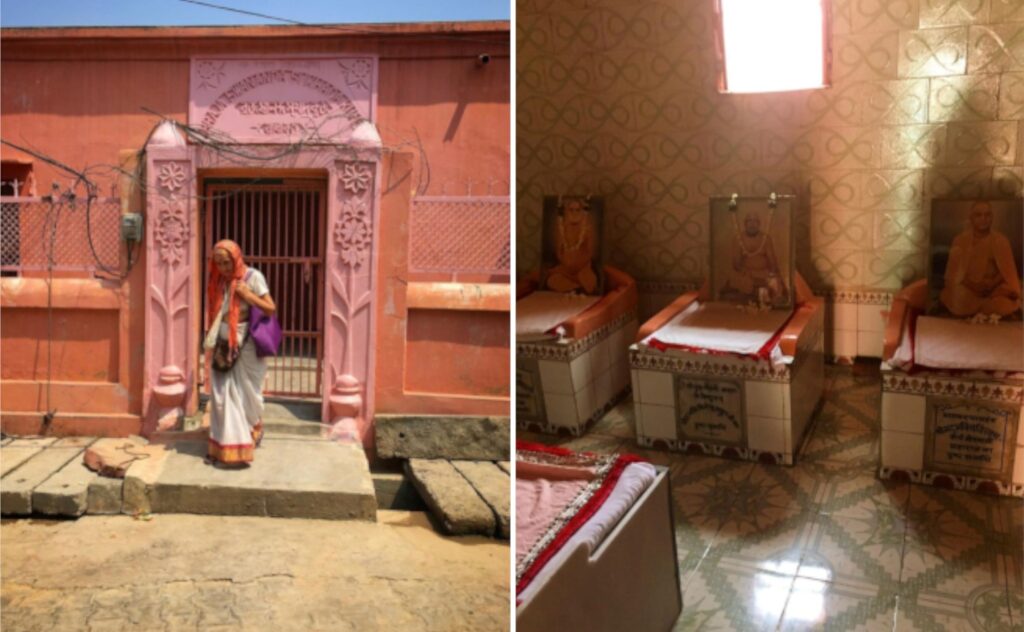
Puspa samadhi for Srila Bhaktivinoda Thakur at Radha-kunda
The Mercy and Kindness of Srila Bhaktisiddhanta Sarasvati
There is a wonderful story showing the kindness, tolerance and mercy of Srila Bhaktisiddhanta Sarasvati Thakur that took place in Bengal in the 1930’s:
Once some devotees were sent to establish a preaching center in Bengal. They worked day and night, equipping it as a beautiful temple. When Srila Bhaktisiddhanta Sarasvati Prabhupada arrived to install the Deities, he was very pleased and asked about one brahmacari who had worked hard on the preparations. The disciples told him, “Master, he became entangled with a lady. We rebuked him so much for his behavior that he fled from this place.”
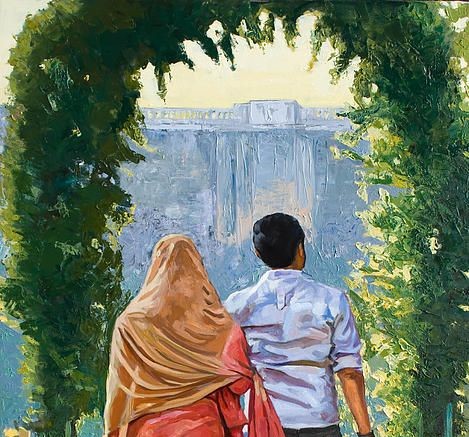
Srila Bhaktisiddhanta Sarasvati Thakur replied, “I don’t want to establish a preaching center here, nor do I want to install the Deities. In this world we spend hundreds of gallons of blood to bring a person out of the clutches of maya. If that person makes some mistake, it will be washed away by his serving Hari, Guru, and Vaisnavas, but you have chastised him and he has gone away. I don’t want to make a center here. Search for him and bring him to me; otherwise I will go away.”
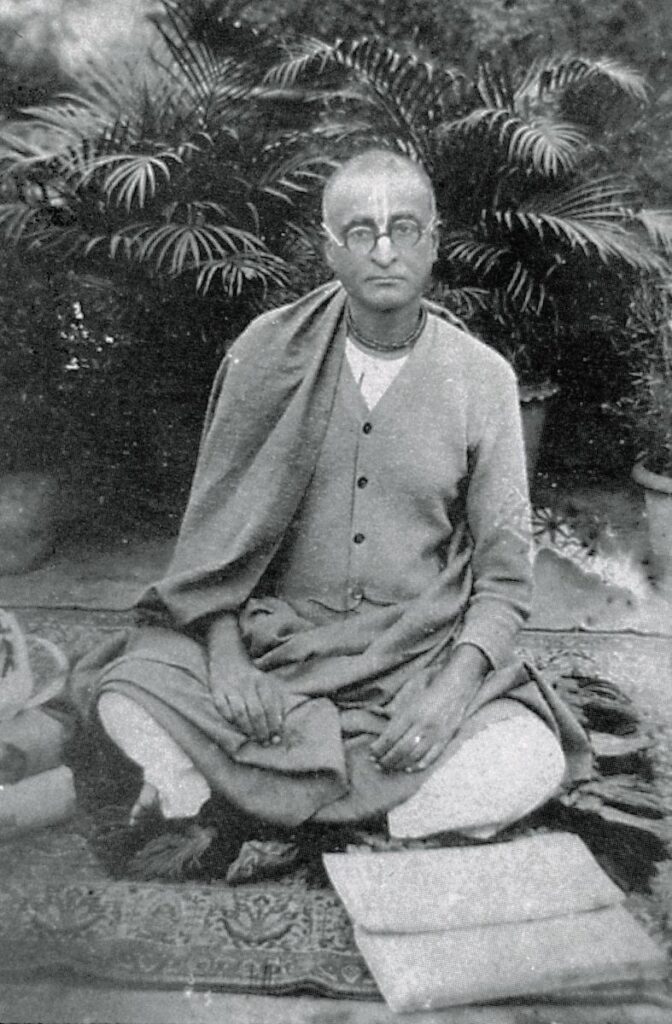
The anxious disciples began to search for that brahmacari. Madhava Maharaja, who At that time was named Hayagriva Brahmacari, found the errant brahmacari, apologised, and asked him to return. The brahmacari wept, saying, “I was serving here, in a watch company, but I was not really happy. I wanted to return, but I was thinking, ‘How can I show my face?’ So I did not return.” He at once went running and weeping to Srila Bhaktisiddhanta Sarasvati Prabhupada, thinking him more merciful than Krishna Himself, and all his *anarthas were washed away in a moment.
[*anarthas: things which are undesirable for bhakti]
Srila Bhaktisiddhanta Sarasvati Thakur told his disciples:
The purport is that we should not criticise anyone, whether a devotee or a worldly person.
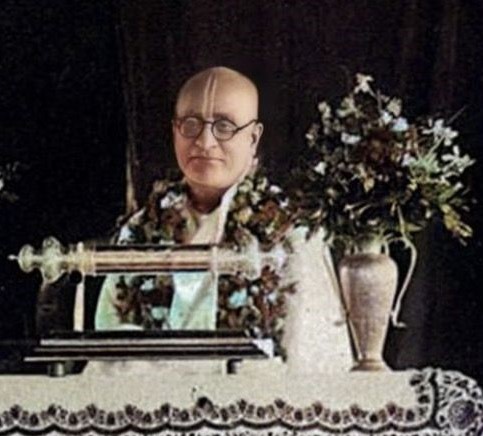
Then he quoted a verse from Srimad Bhagavatam:
The Supreme Personality of Godhead said, “One should neither praise nor criticise the conditioned nature and activities of other persons. Rather, one should see this world as simply the combination of material nature and the enjoying souls, all based on the Absolute Truth. Whoever indulges in praising or criticising the qualities and behaviour of others will quickly become deviated from his own best interest by his entanglement in illusory dualities.
[Srimad-Bhagavatam 11:28:1-2]
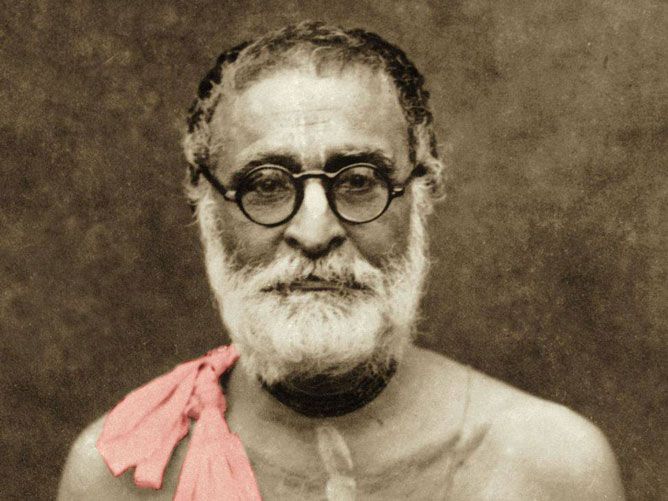
Srila Bhaktisiddhanta Sarasvati Thakur continued:
To bring a person from the clutches of maya is very, very hard. If lust or any other attachment is present in that person’s heart it will go away very soon, if he is chanting and remembering and listening to hari-katha. Be very careful. Don’t criticise devotees or non-devotees. First look at your own condition, and try to purify yourself. Is there any lust in you? Is there any kutinati (deceit) in you, or not? Be worried about that; don’t worry about others. Sri Guru and Lord Sri Krishna are responsible for others. You cannot do anything to help them, therefore you have no right to criticise.
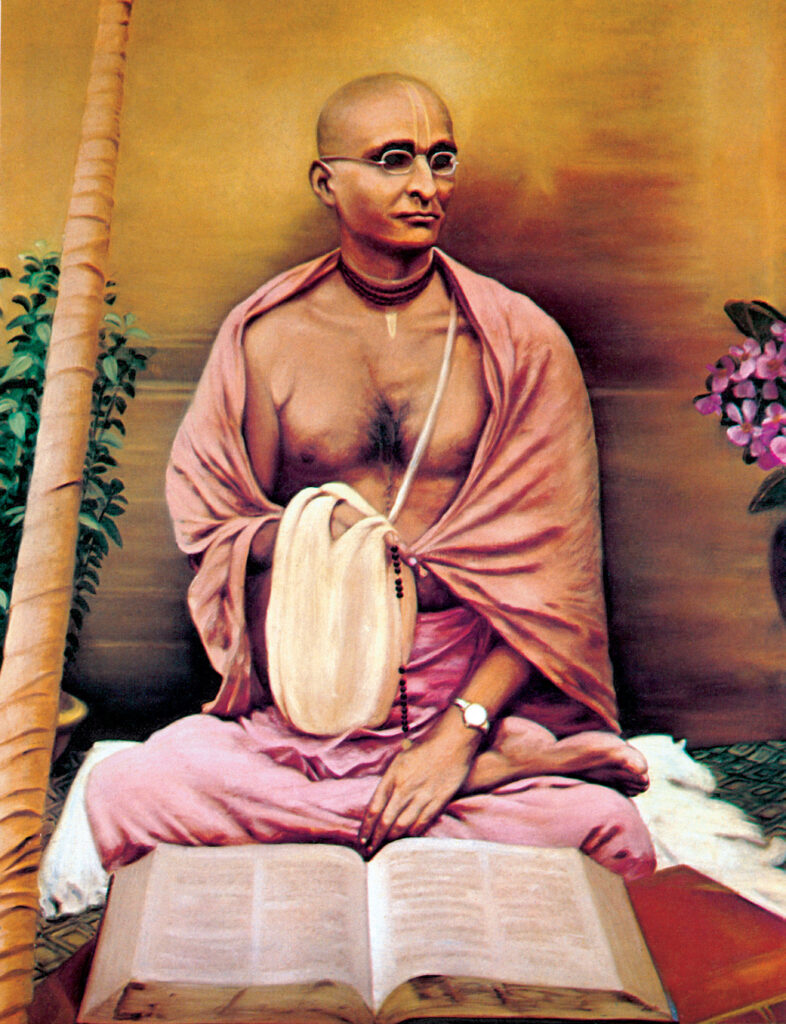
Srila Bhaktisiddhanta Sarasvati has further said:
When faults in others misguide and delude you, have patience, introspect, and find faults in yourself. Know that others cannot harm you unless you harm yourself.

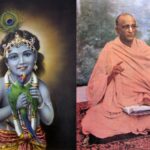
3 Comments
Wonderful! Many thanks>
You have done very nice presentations on here with great photos and pictures. I feel that there should be a section also on A.C. Bhaktivedanta Swami Srila Prabhupada in an expansive way. He carried on the preaching of his gurudeva and fulfilled the desires of Bhaktisiddhanta Sarasvati and Thakur Bhaktivinode and indeed Lord Chaitanya. Without his empowered mercy none of the world would know of pure Krishna bhakti. By his steady determination against all odds and oppositions he forcefully spread the teachings of Lord Chaitanyadeva everywhere and established many temples and ashramas throughout the world and this is still going on expanding. Nitai Gauranga. Hare Krishna.
Namaste, and thank you for your kind words and encouragement.It is my intention to attempt to glorify Srila Bhaktivedanta Swami Prabhupad in the next post.Unfortunately I am awaiting cataract surgery at present and struggle to use my computer. Will get onto it a.s.a.p. Haribol, Kenarama das